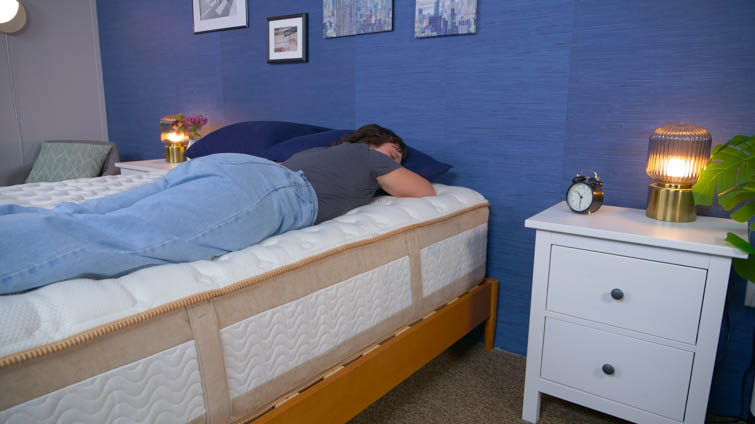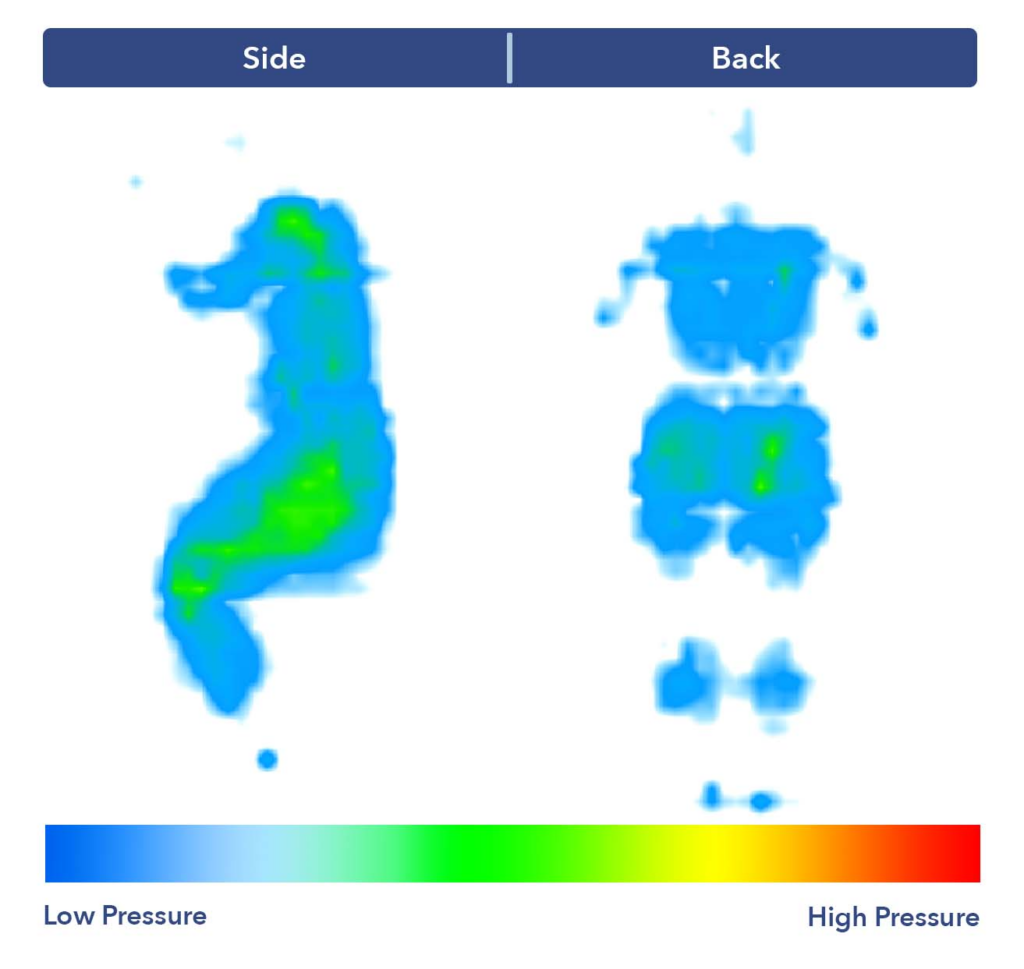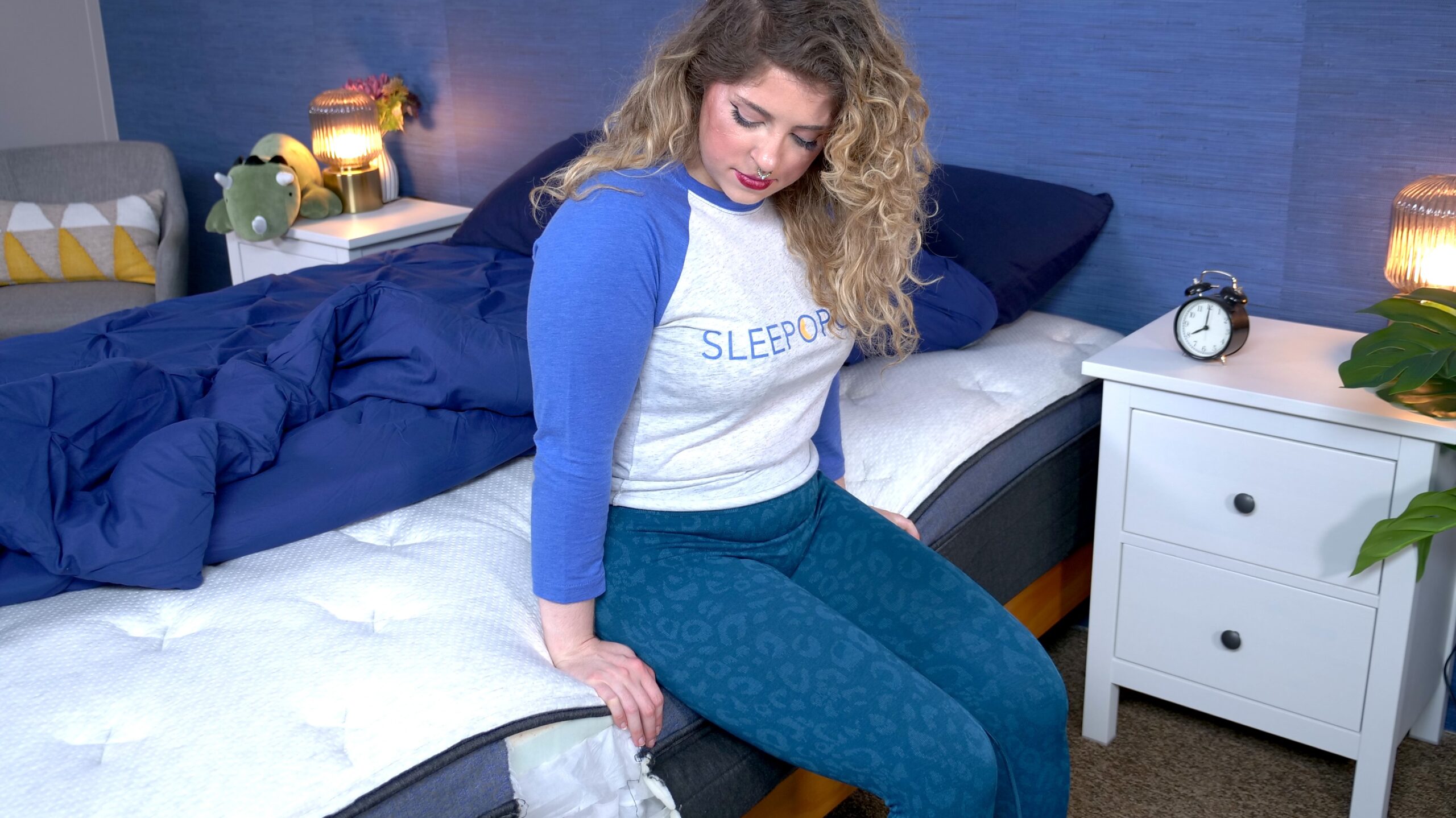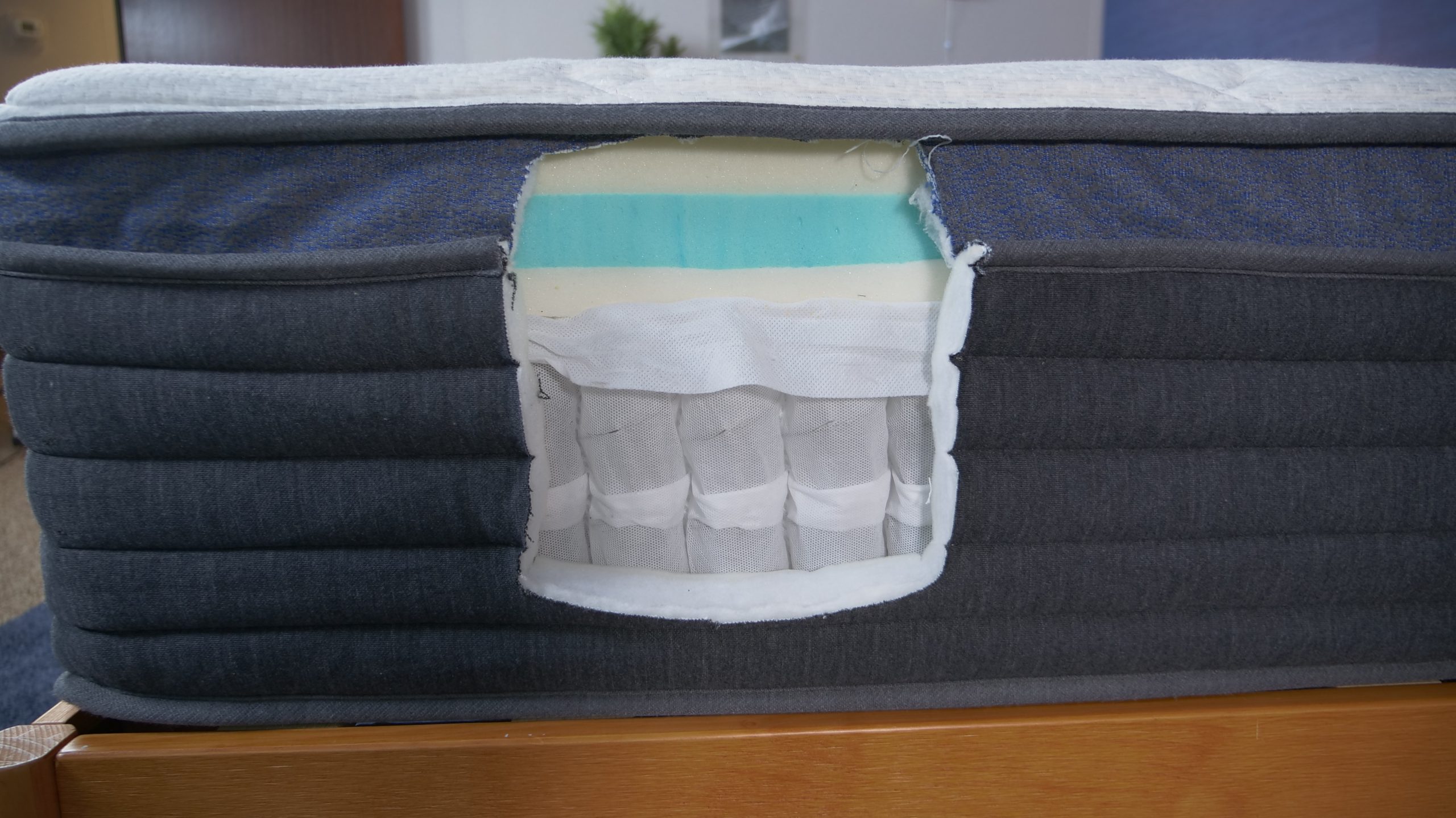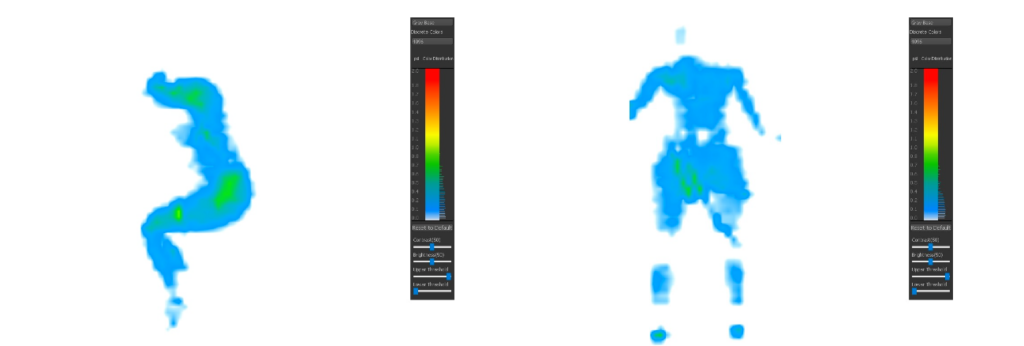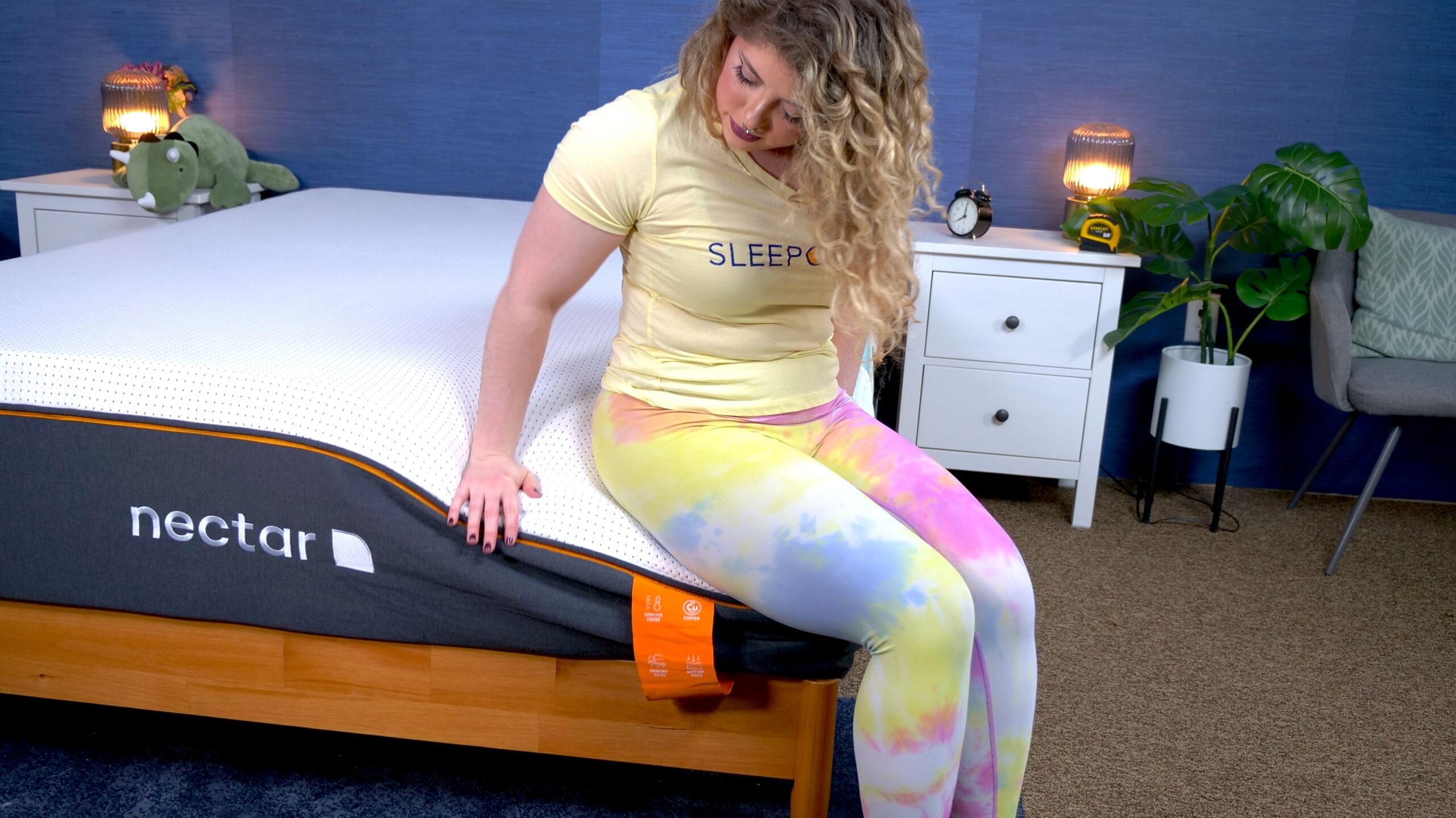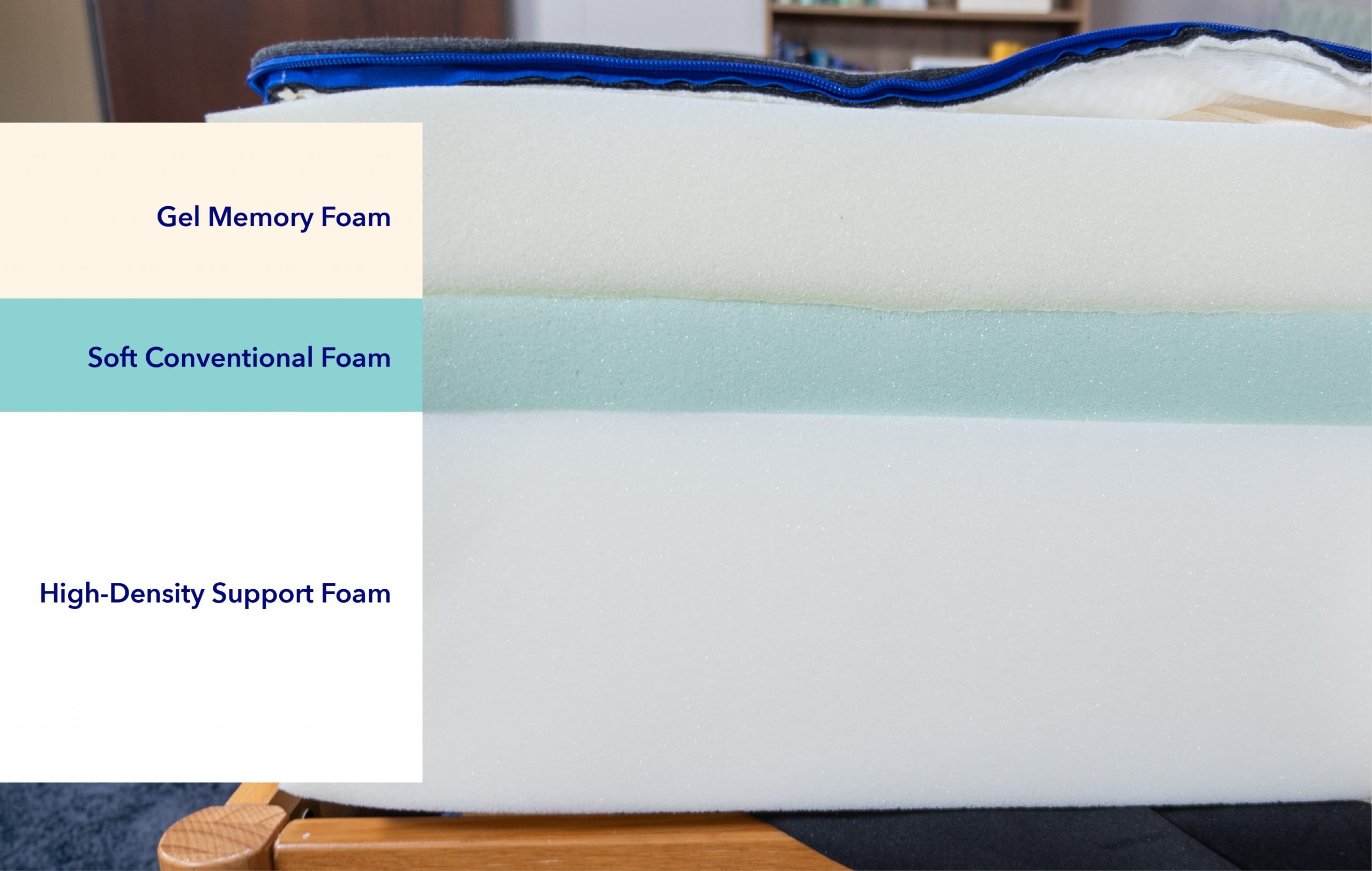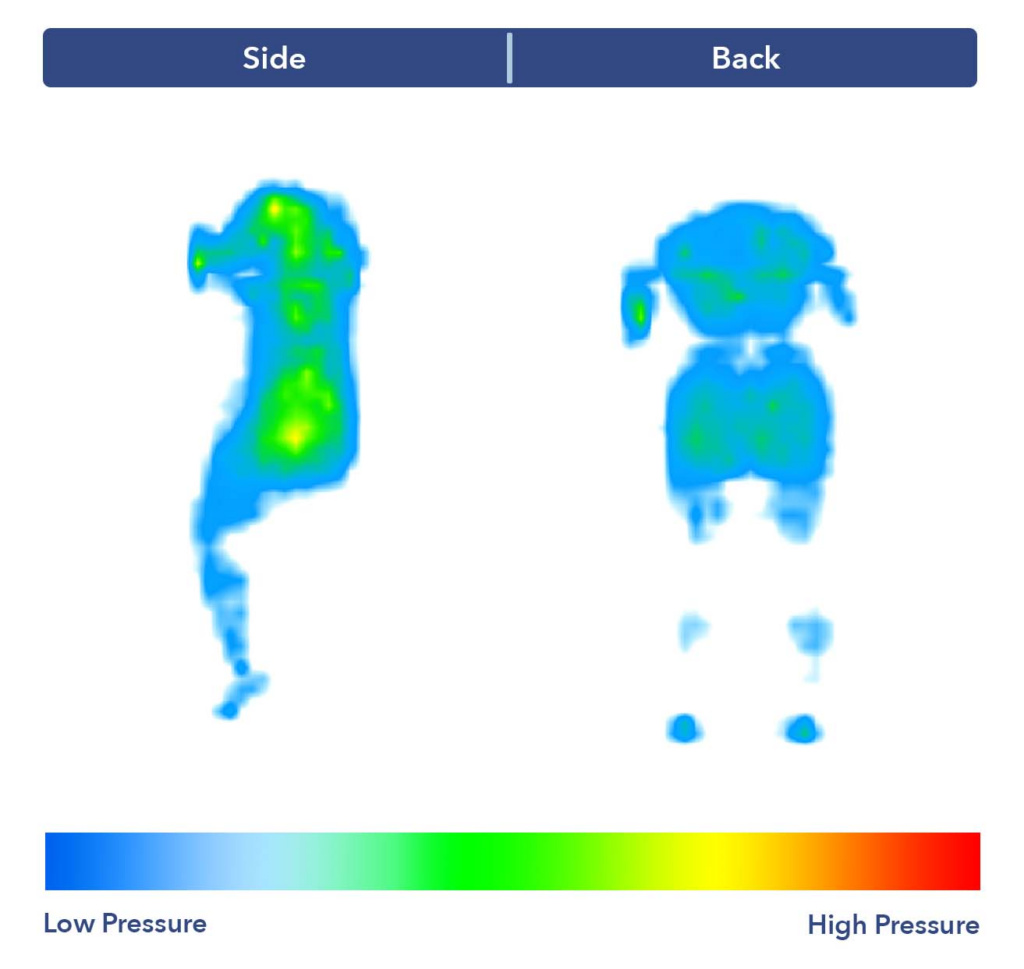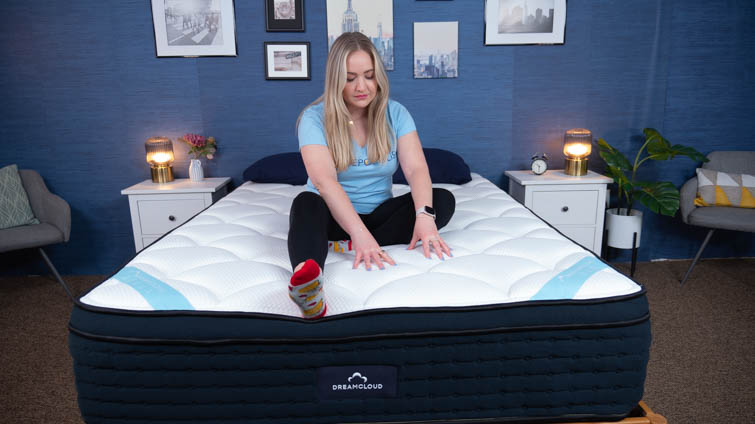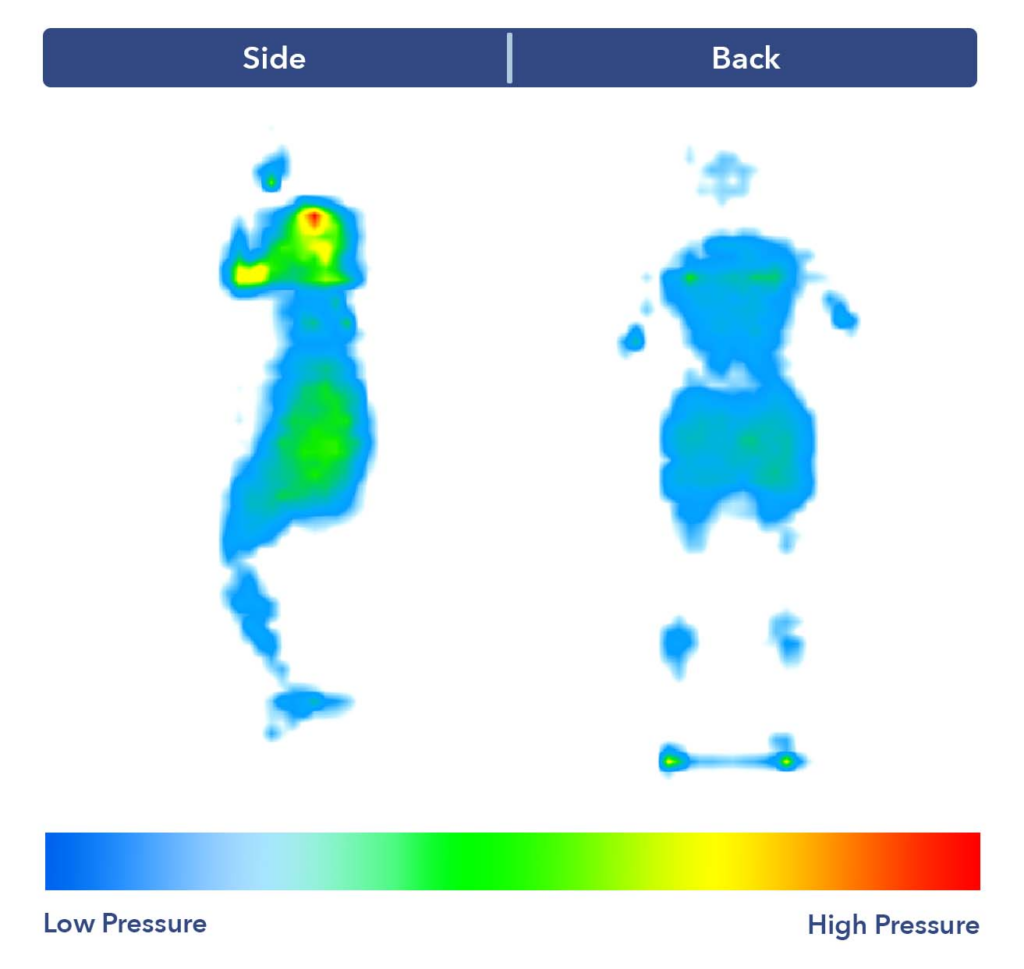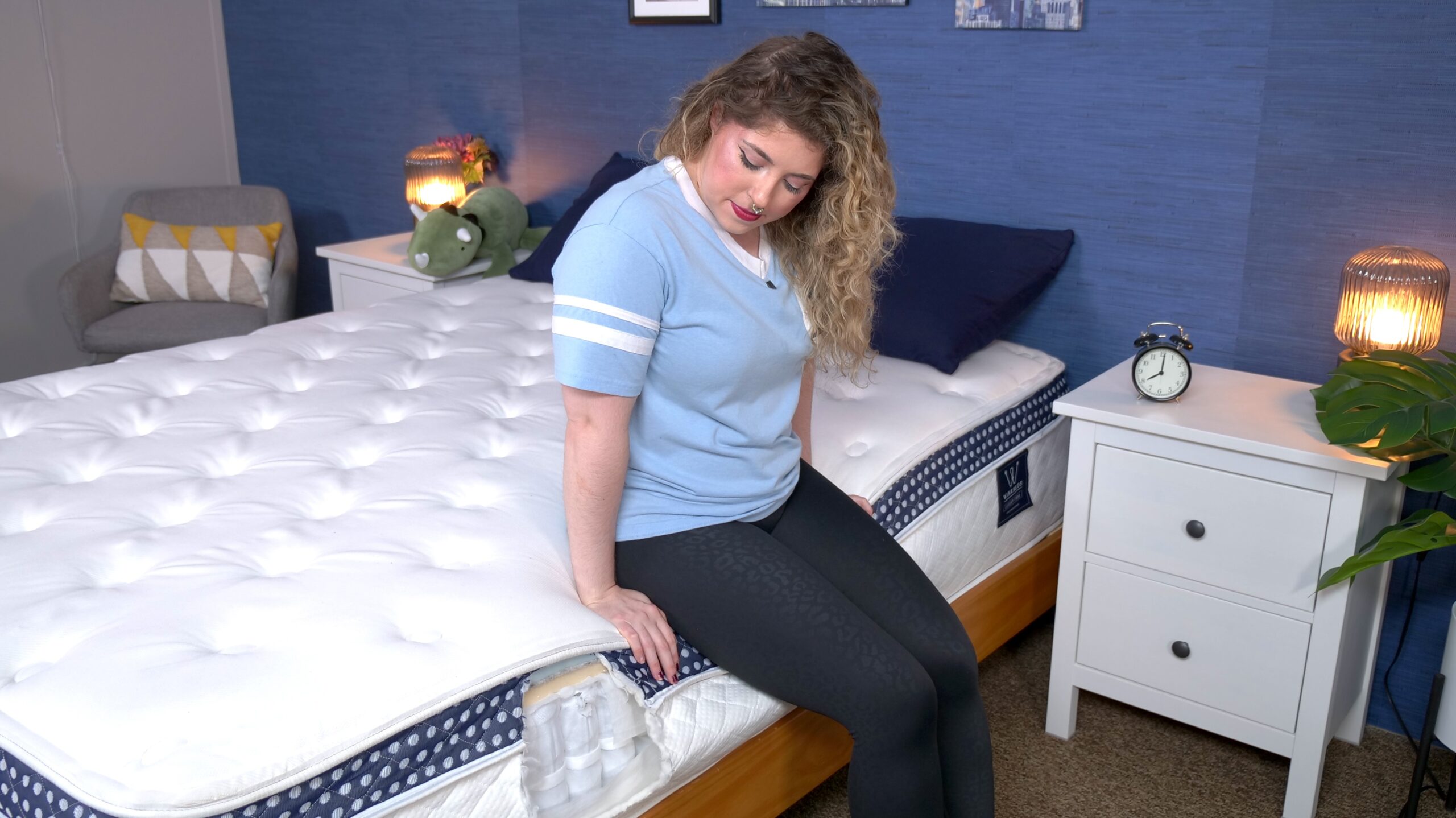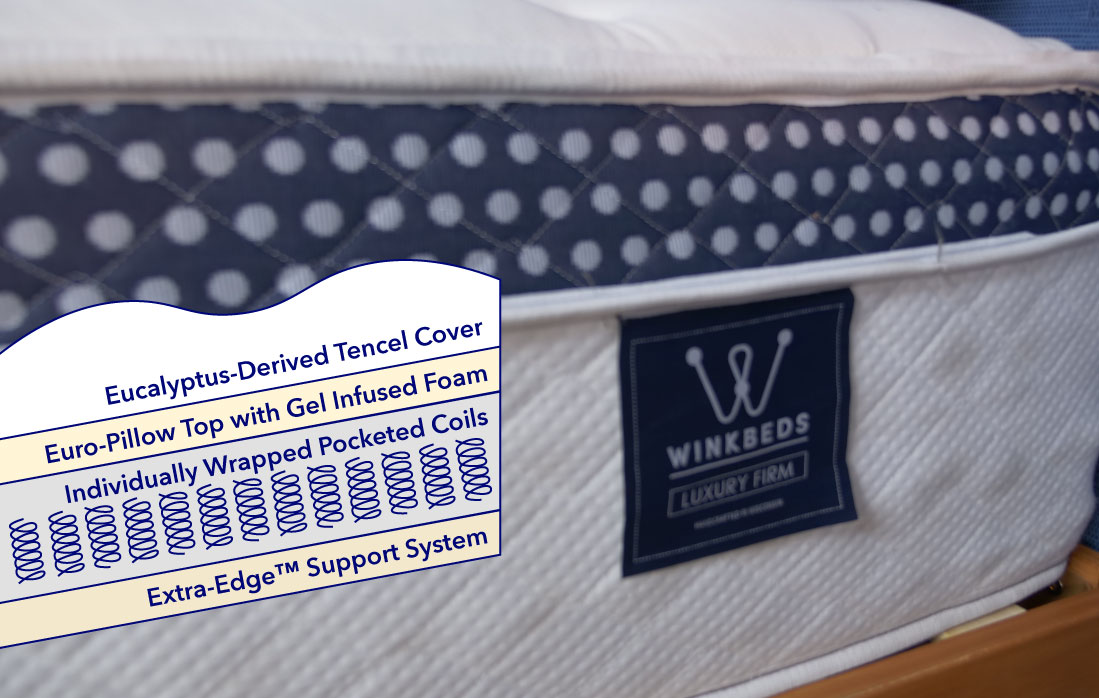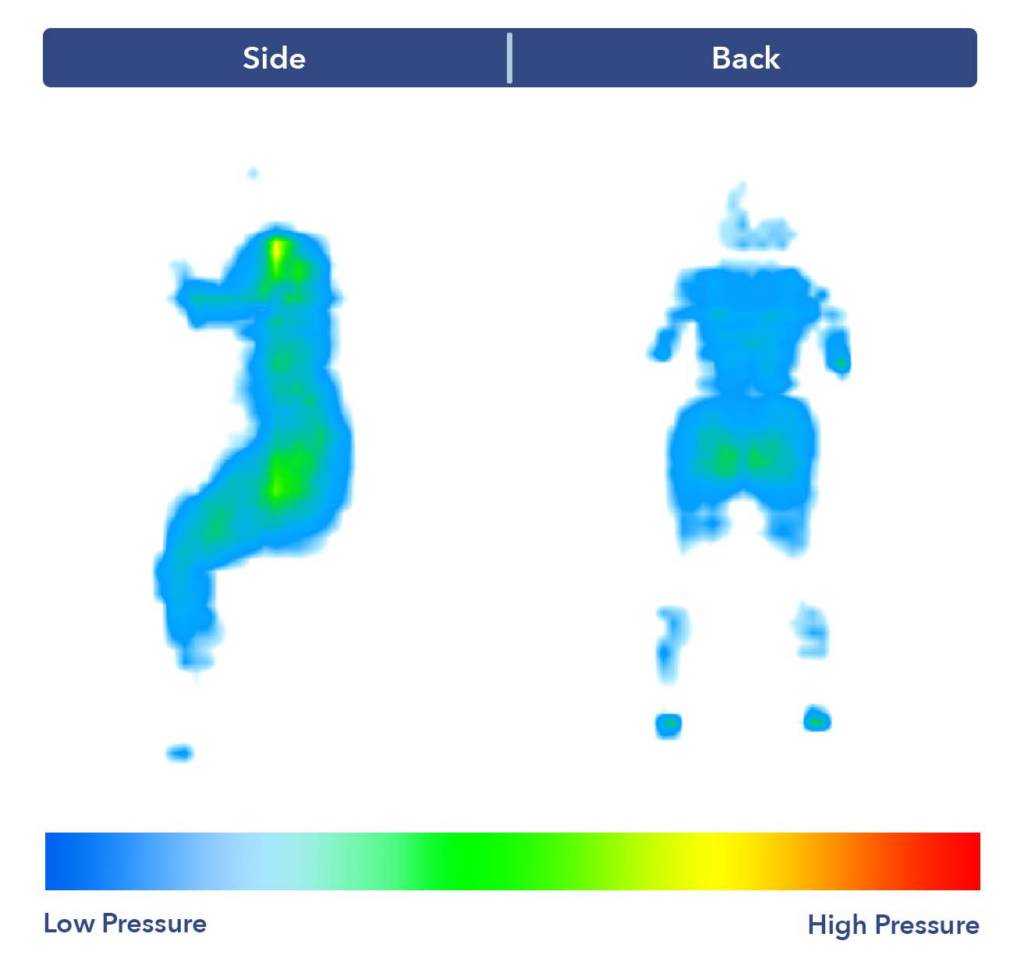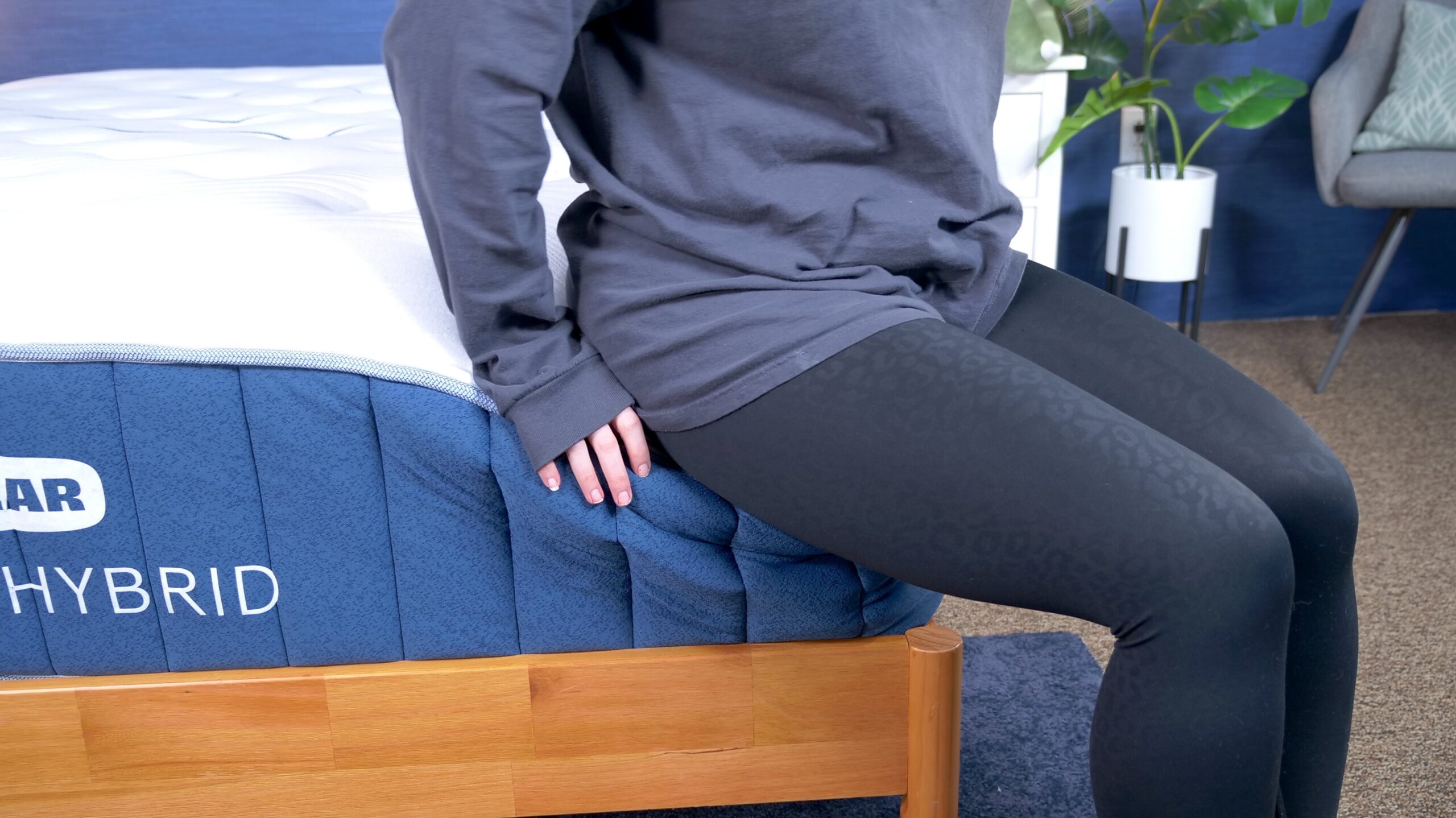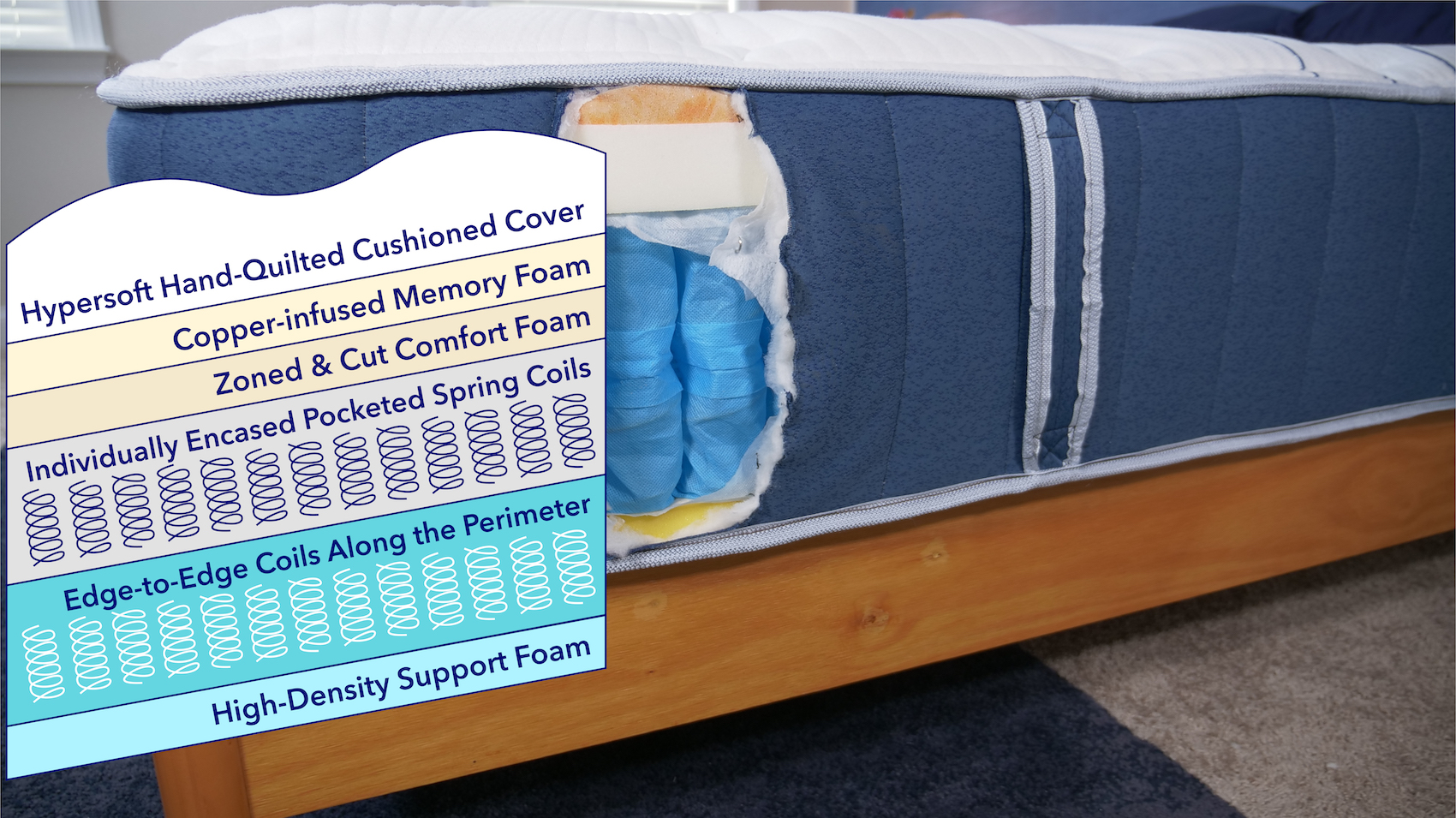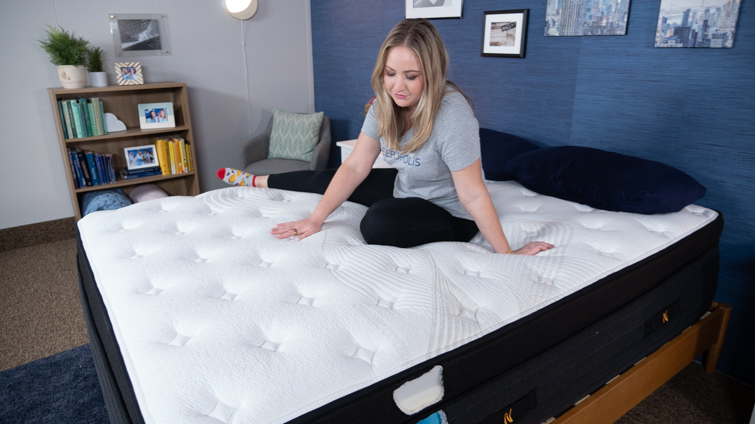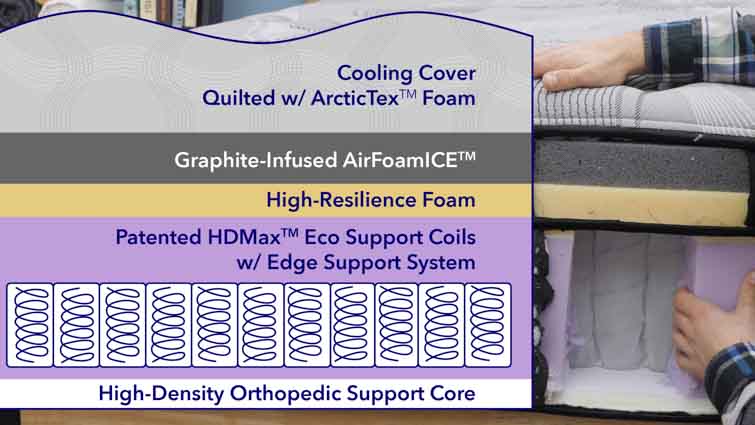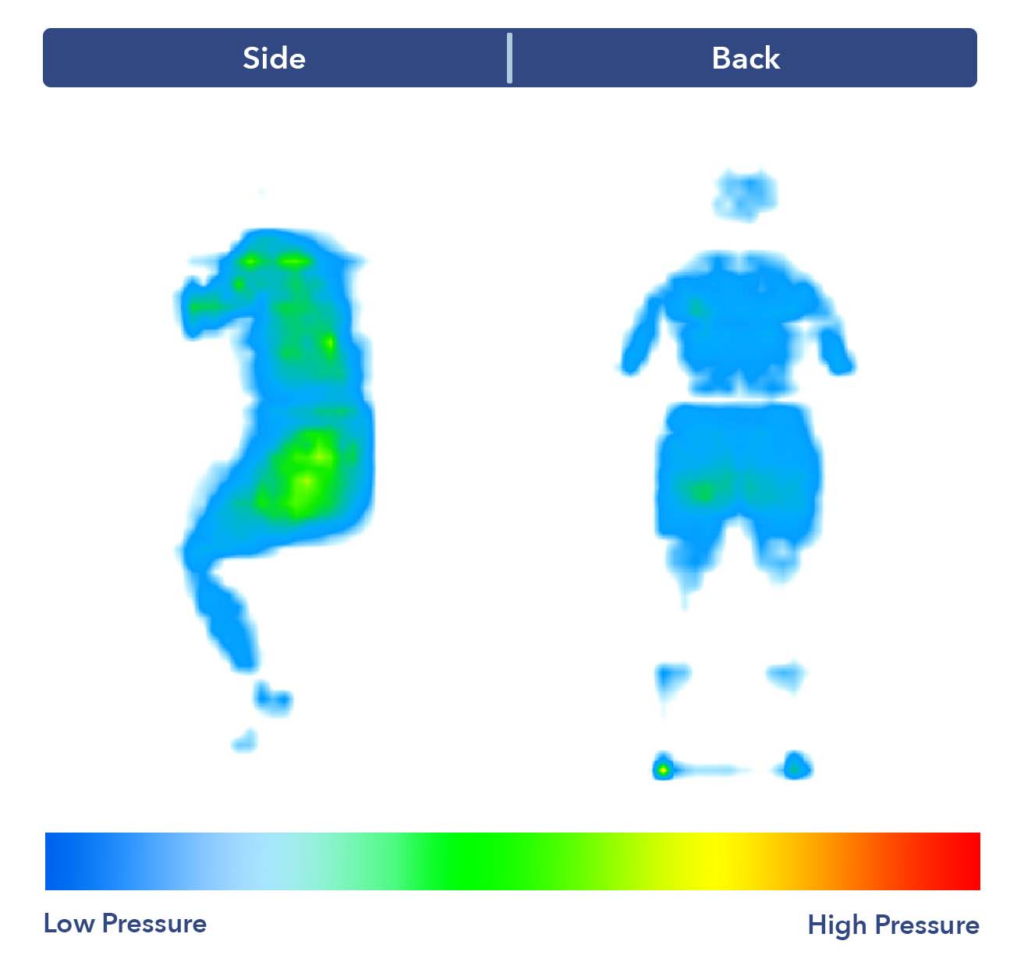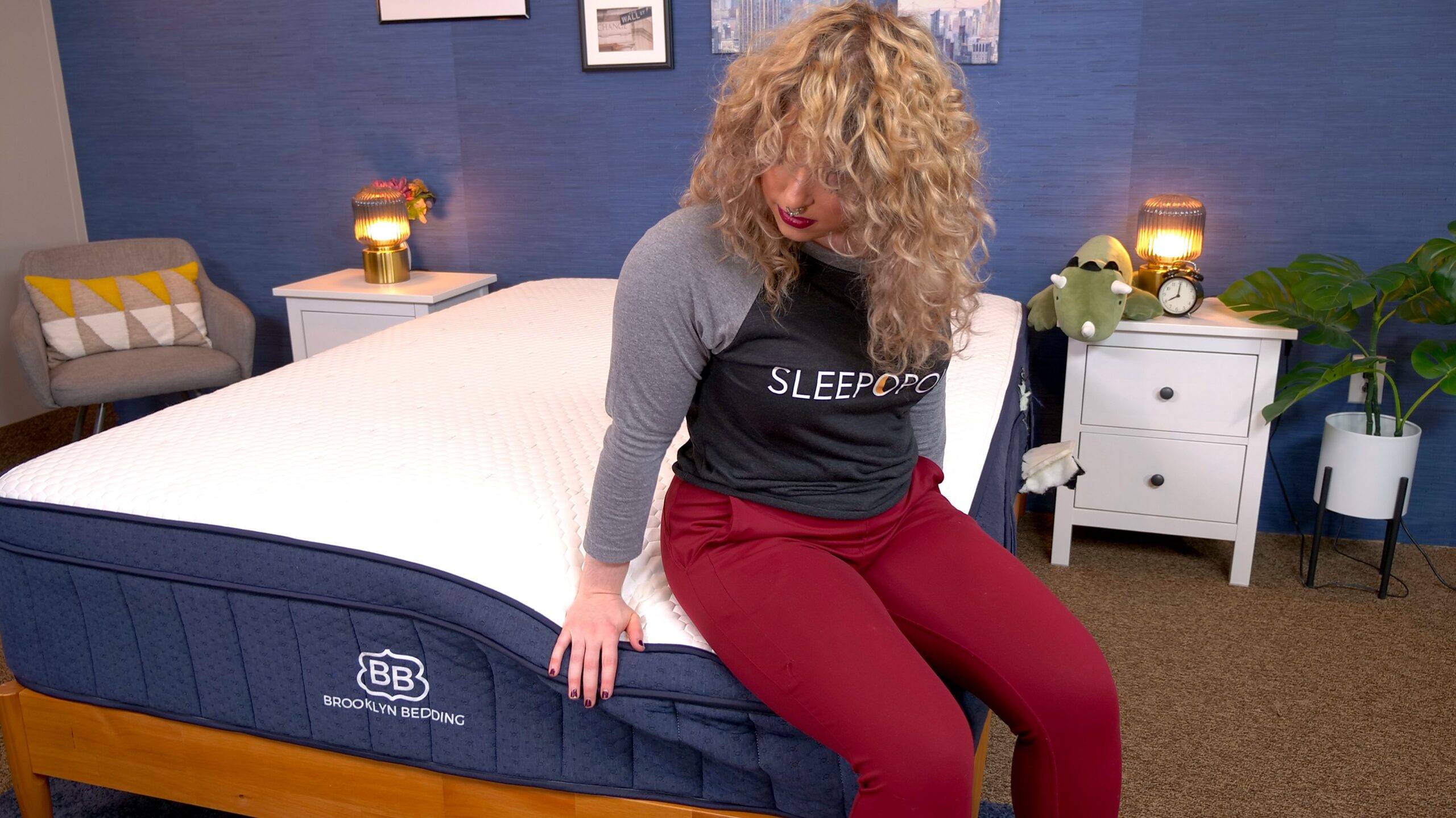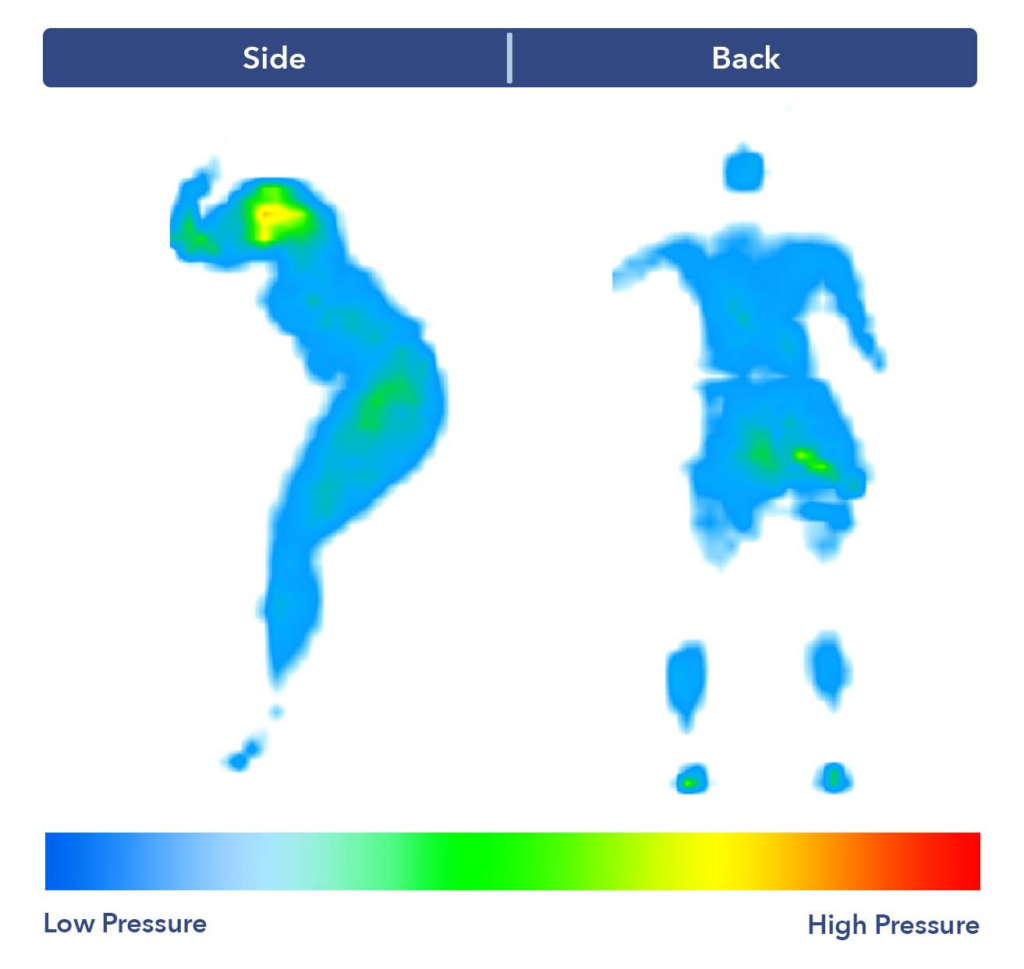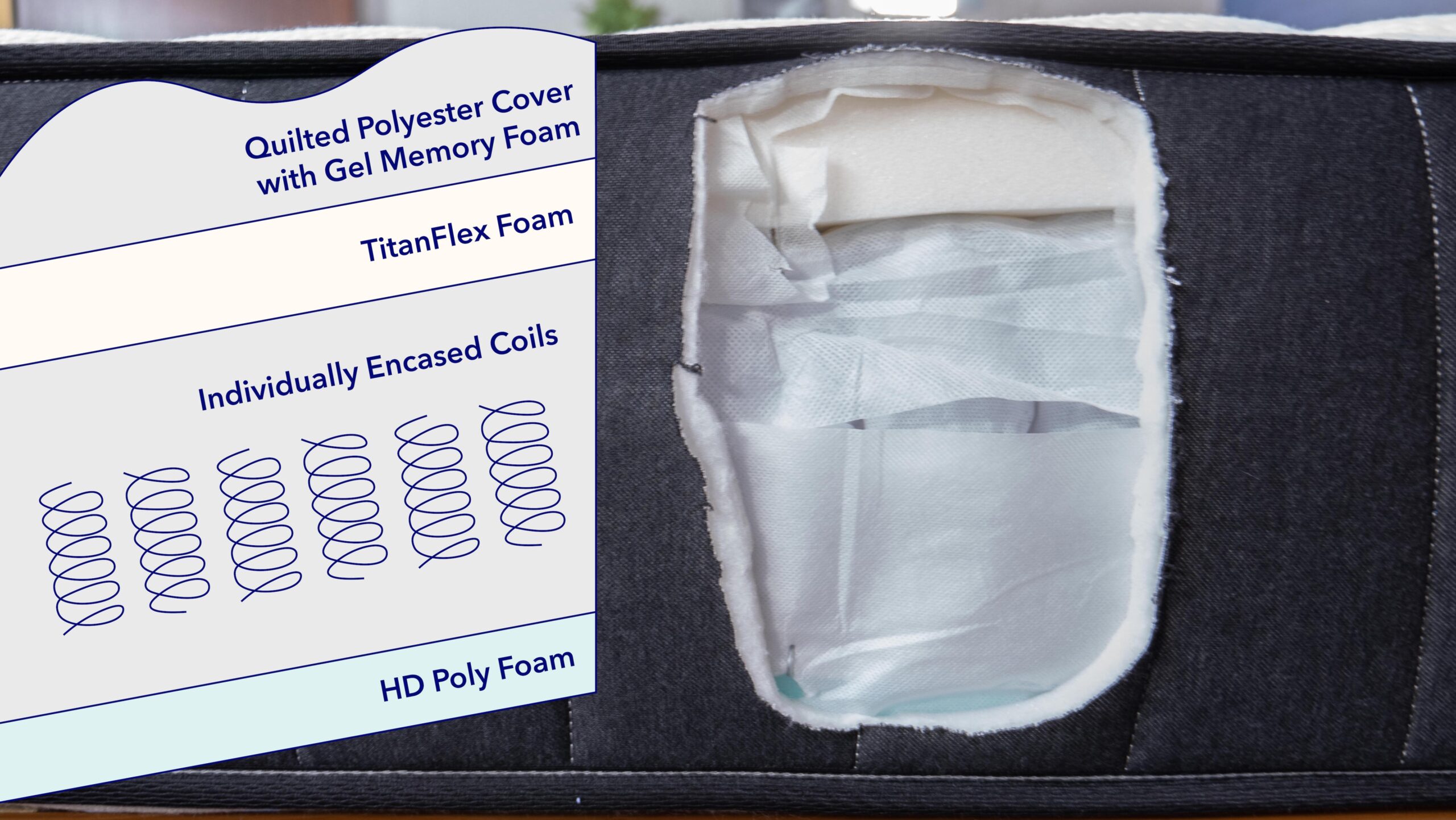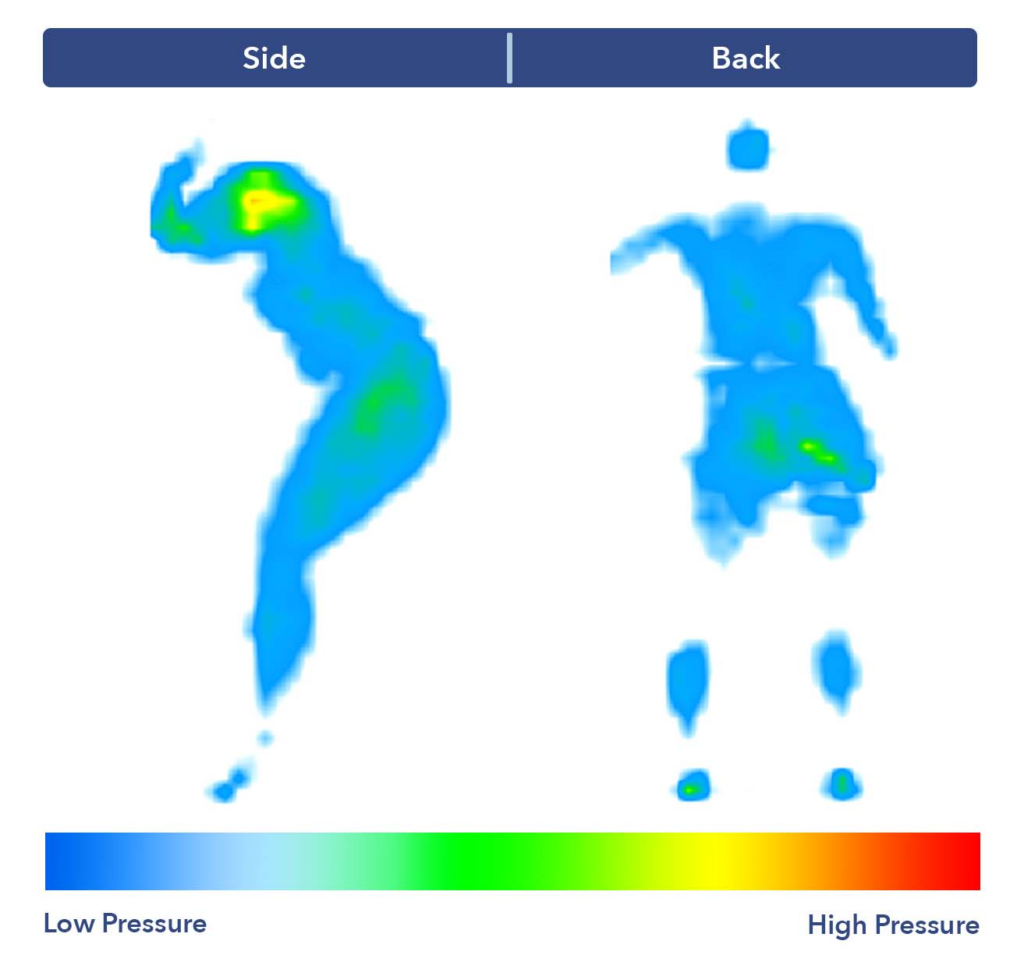Restful sleep is crucial for optimal health and quality of life. If you have hip pain, a good night’s slumber can be elusive, particularly if you’re sleeping on the wrong mattress. In this roundup, we’ll guide you through the process of finding the best mattress for hip pain step-by-step, including a Buyer’s Guide at the end that will help you understand how the condition can impact sleep.
To pick the best mattresses for hip pain, we ran each one through a series to tests to see how well they performed in areas such as pressure relief, cooling, and more. We paid special attention to pressure and pain relief at the hips, and cooling for added comfort.
Our Top Pick for Hip Pain
The Saatva Rx has enough pressure relief to alleviate aches and pains at the hips, while still providing enough support with its springs to keep your spine neutrally aligned.
Best Mattresses for Hip Pain of 2024
- Saatva Rx – Best Overall
- Helix Midnight Luxe – Best Mattress for Hip Pain and Back Pain
- Nectar – Best Affordable Mattress for Hip Pain
- DreamCloud Premier – Best Mattress for Couples
- WinkBeds Original – Best Mattress for Heavy People with Hip Pain
- Bear Elite Hybrid – Best Mattress for Side Sleepers with Hip Pain
- Nolah Evolution – Best Mattress for Shoulder and Hip Pain
- Brooklyn Bedding Aurora Luxe – Best Mattress for Arthritis
- Titan Plus – Best Mattress for Stomach Sleepers with Hip Pain
Best Mattress for Hip Pain Video Review
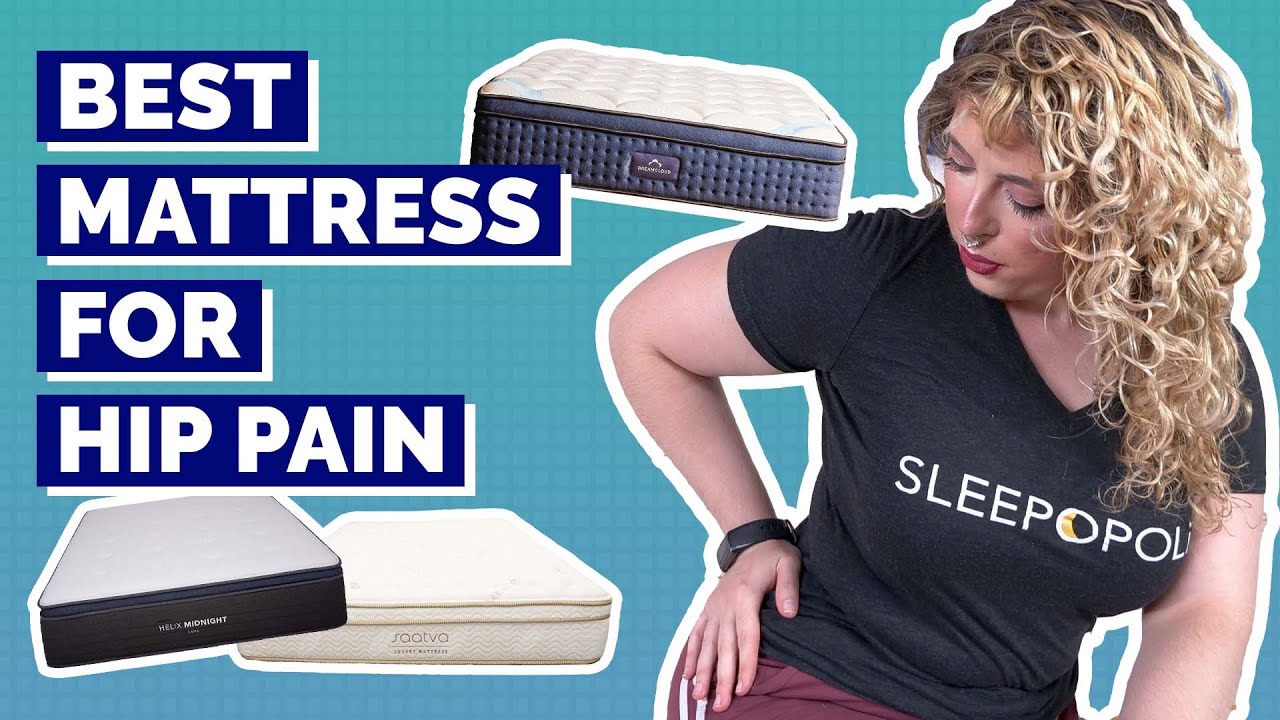
Note: The content on Sleepopolis is meant to be informative in nature, but it shouldn’t take the place of medical advice and supervision from a trained professional. If you feel you may be suffering from any sleep disorder or medical condition, please see your healthcare provider immediately.
What We Look For In The Best Mattresses For Hip Pain
Firmness and Spinal Alignment
When shopping for a mattress for hip pain, one of the most important things to consider is how the mattress will help to align your spine, and have enough firmness to keep that alignment healthy. We tested all of the mattresses in this lineup for their alignment and firmness properties using our firmness scale. This scale goes from 1-10, with 10 being the most firm. We recommend that people with hip pain opt for a mattress around a 6 to ensure they are good for alleviating hip pain.
Pressure Relief
We know that pressure relief is important for any mattress shopper, but it is especially important for those looking to relieve hip pain. With this in mind, we used a pressure map to test all of these mattresses and ensure they relieved pressure on the hips to help alleviate pain.
Contouring Ability and Comfort
We know it is important to you to have a comfortable mattress that still helps alleviate hip pain, so we tested these mattresses to make sure they can perfectly contour your body for optimum comfort all night.
Compare the Best Mattresses for Hip Pain
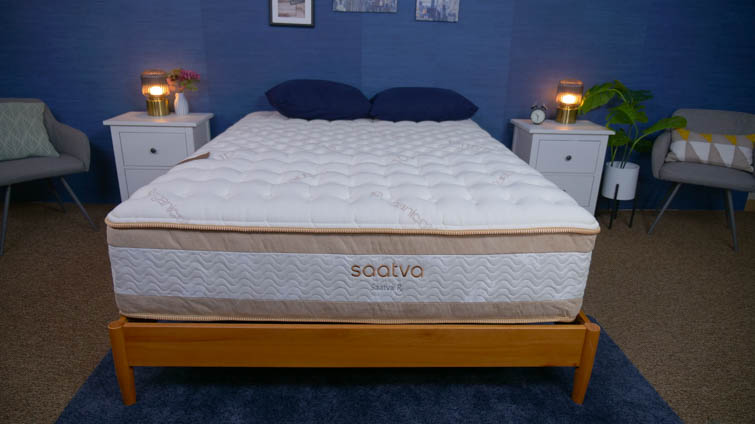
|
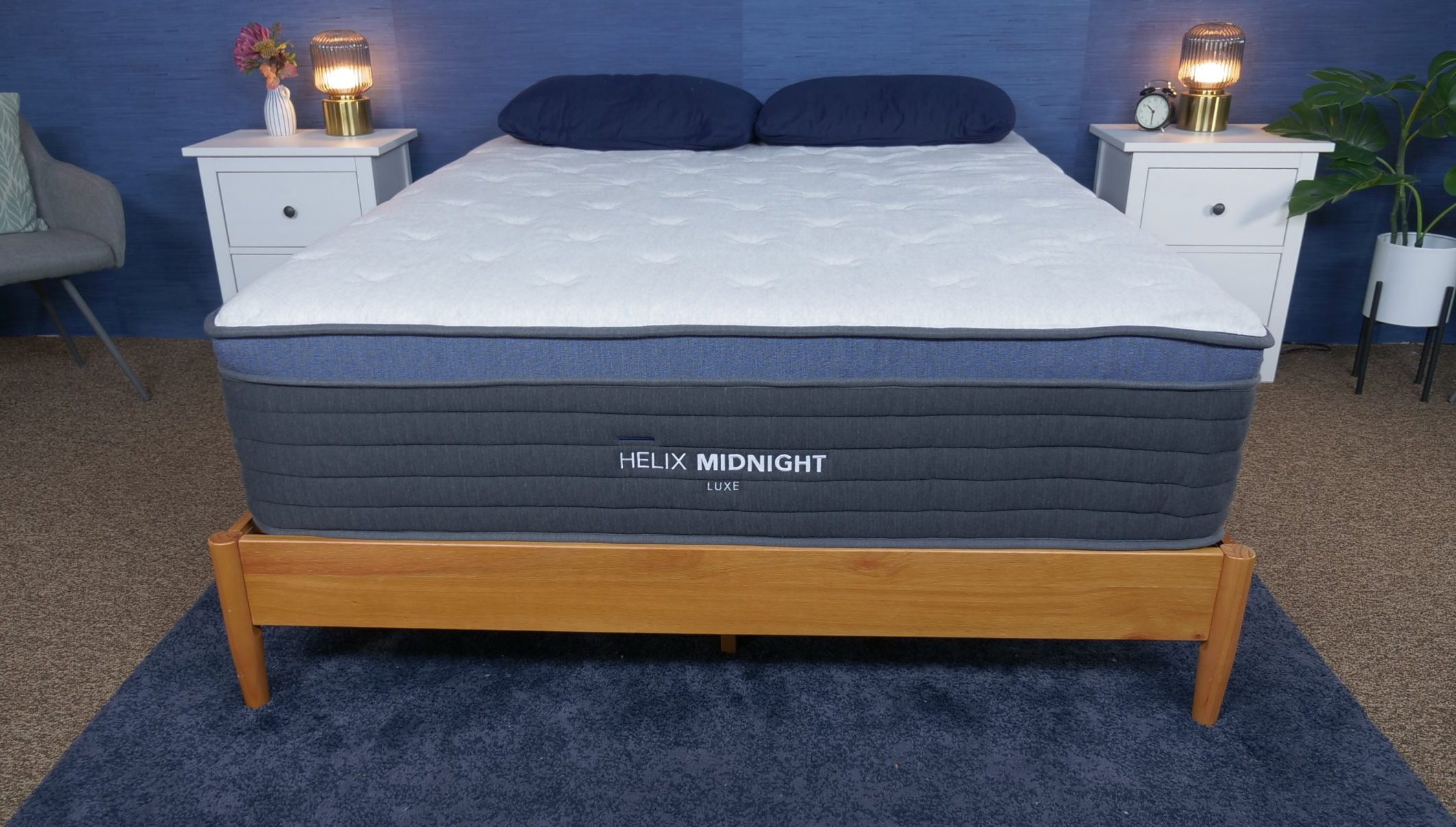
|
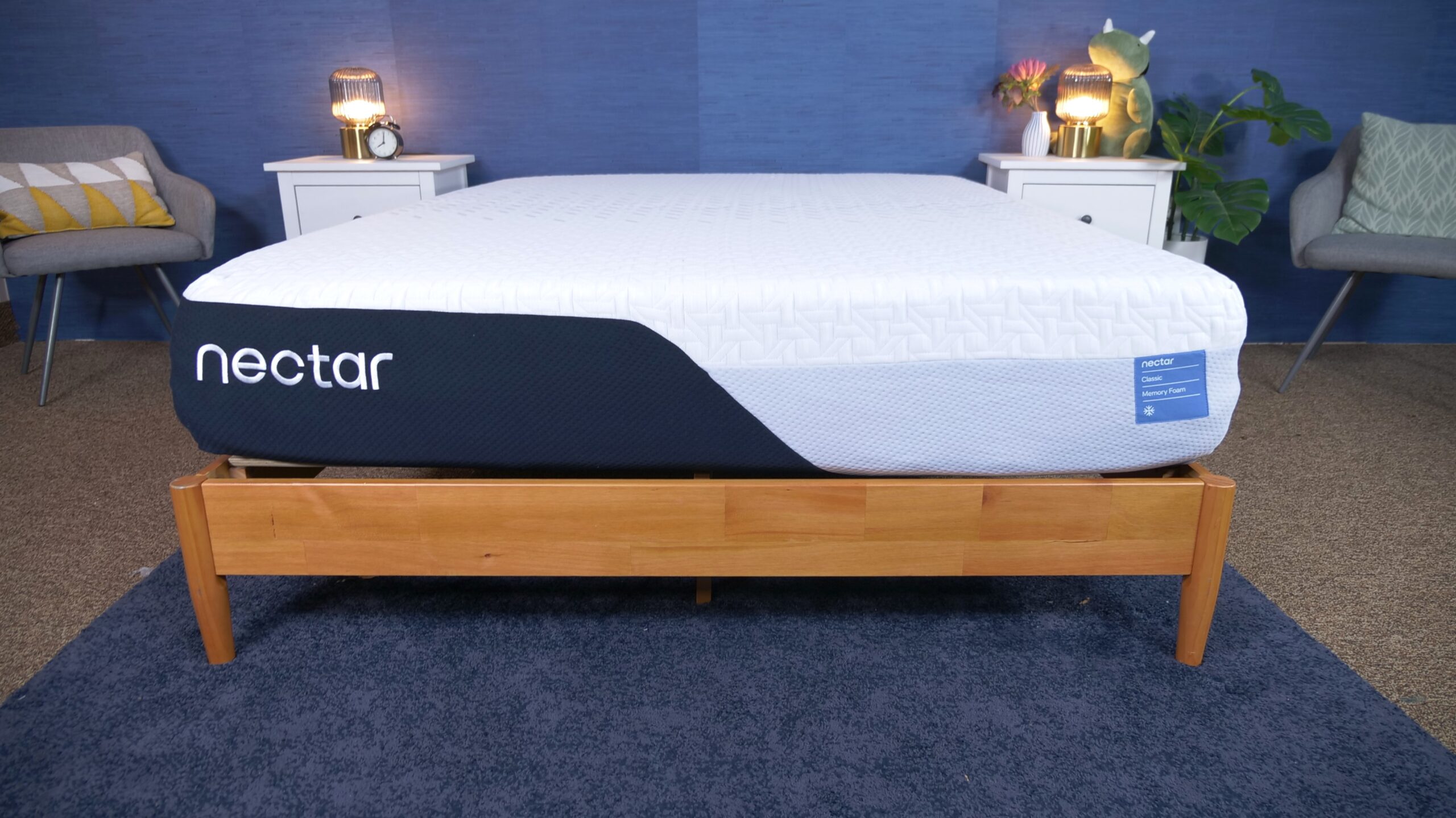
|
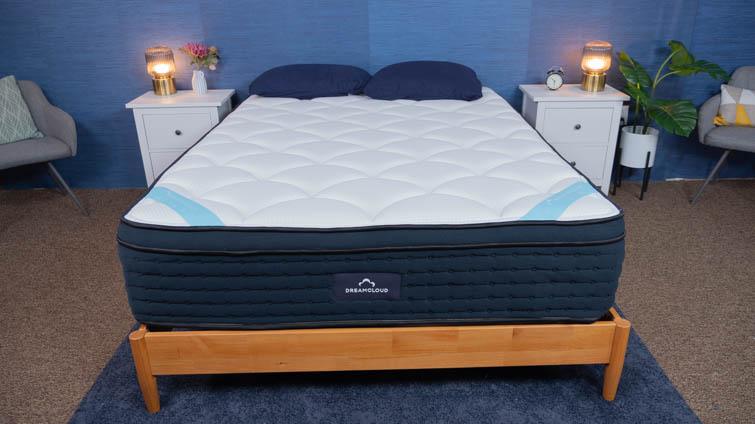
|
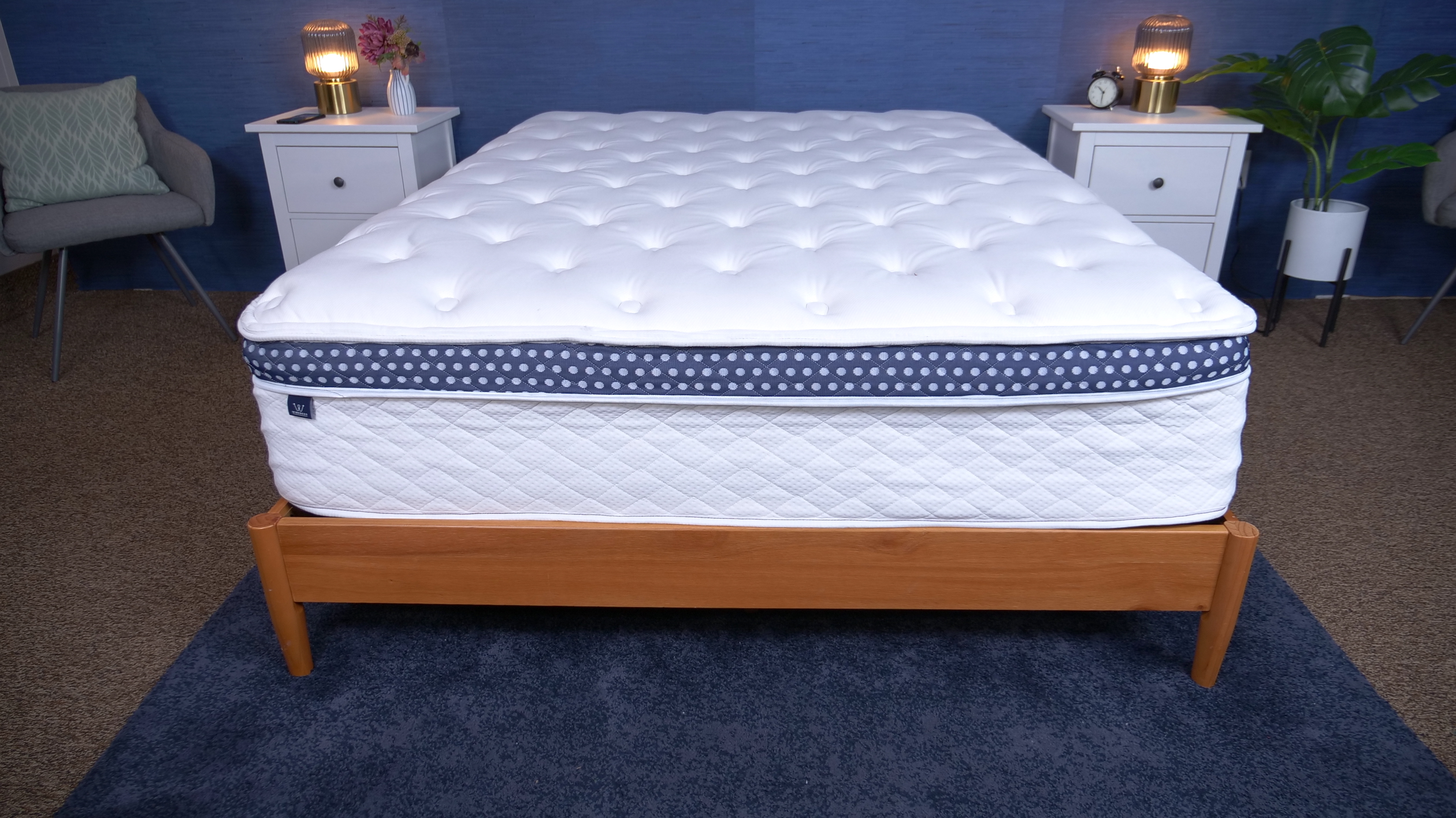
|

|
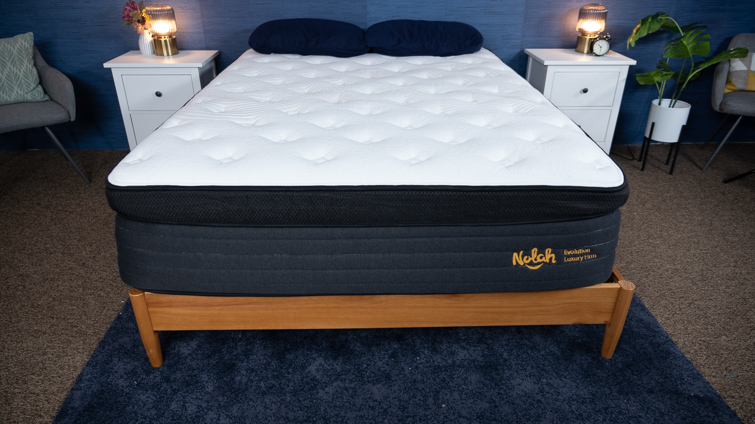
|
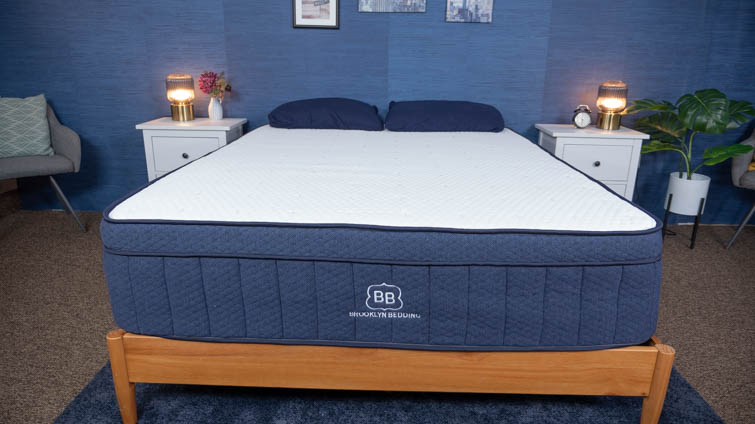
|
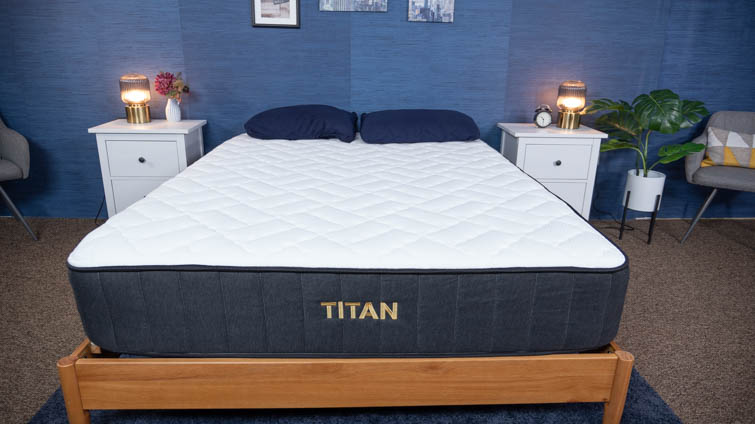
|
|
| Saatva Rx Mattress | Helix Midnight Luxe Mattress | Nectar Mattress | DreamCloud Premier Mattress | WinkBed Mattress | Bear Elite Hybrid Mattress | Nolah Evolution Hybrid Mattress | Brooklyn Bedding Aurora Luxe Mattress | Titan Plus | |
| Rating | |||||||||
| Firmness | Medium-firm: 6.5/10 | Medium-soft: 6/10 | Medium-firm: 6.5/10 | Firm: 7/10 | Firm: 7/10 | Multiple firmness options | Multiple firmness options | Multiple firmness options | Firm: 7.5/10 |
| Material | Hybrid | Hybrid | Foam | Hybrid | Hybrid | Hybrid | Hybrid | Hybrid | Hybrid |
| Cooling | — | — | — | — | — | ||||
| Best For |
Back Pain, Hip Pain, Stomach Sleepers, Side Sleepers, Back Sleepers
|
Back Sleepers, Stomach Sleepers, Side Sleepers, Hip Pain, Seniors
|
Back Sleepers, Back Pain, Stomach Sleepers, Side Sleepers, Couples
|
Back Sleepers,
Hot Sleepers |
Back Sleepers, Stomach Sleepers, Back Pain, Hot Sleepers, Side Sleepers
|
Back Sleepers, Stomach Sleepers, Hot Sleepers, Hip Pain, Seniors
|
Side Sleepers, Back Sleepers, Hip Pain, Seniors,
|
Hot Sleepers,
Back Pain, Side Sleepers |
Back Sleepers, Stomach Sleepers, Back Pain, Hip Pain, Seniors
|
Saatva Rx – Best Overall
Designed specifically for sleepers with back pain and joint pain, the Saatva Rx features several layers that combine both foam and coils. This creates a blend of comfort and support throughout the entire mattress that’s cushioning enough for any aches and pains while still being sturdy enough for a neutral spinal alignment. Learn more in our Saatva Rx video review.
What our tester says:
“I found that this bed has a supportive feel that easily works for people of all weights, but still feels plush and comfortable.” – Amelia Jerden, senior staff writer
Helix Midnight Luxe – Best Mattress for Hip Pain and Back Pain
Helix has a line of six hybrid mattresses, each with a different level of firmness. The Midnight is one of their medium models. It has enough contouring for side sleepers, but should still be supportive enough for back sleepers, as long as they don’t mind a softer bed. Learn more in our video review.
What our tester says:
“I like the Helix Midnight Luxe for back sleepers and side sleepers. The medium-soft to medium-firm feel should give these folks the right balance of comfort and support.” – Nichole Mondshein, lead reviewer and mattress tester
Nectar – Best Affordable Mattress for Hip Pain
The Nectar delivers on classic memory foam: it’s soft, contouring, and provides a slow-sinking feel. Still, it provides solid support for most light to average weight sleepers. The cushioning memory foam allows for plenty of pressure relief on pain points, like shoulders and hips. Side sleepers especially should enjoy the pressure relief. Plus, a lengthy trial period, lifetime warranty, and affordable price make the Nectar a reassuring choice for many. Watch our video review to learn more.
What our tester says:
“I think memory foam lovers should be happy on the Nectar. This bed has a classic memory foam feel, so there’s lots of sinkage, contouring, and pressure relief. This can be great for anyone with shoulder pain or hip pain since it gives them cushioning at sensitive pressure points.” – Nichole Mondshein, lead reviewer and staff writer
DreamCloud Premier – Best Mattress for Couples
The DreamCloud Premier’s construction is a thoughtful, luxurious take on the company’s flagship mattress. It uses a hybrid of foam and coils to achieve a firmer feel that’s still pressure-relieving. We think many back sleepers and stomach sleepers should appreciate this mattress. With such versatility and many special features, the Premier is well-equipped to cater to couples. Learn more in our DreamCloud Premier video review.
What our tester says:
“From the cashmere cover to the Euro top, you’re getting a lot of bang for your buck with this bed. I really like how this mattress combines sturdy support with cozy pressure relief — making it a great choice for back sleepers.” – Bridget Chapman, former Sleepopolis senior product editor
WinkBeds Original – Best Mattress for Heavy People with Hip Pain
The WinkBed is a luxury hybrid mattress. It has a similarly supportive and sturdy feel to a traditional innerspring mattress, but upgrades like a Euro top and cooling Tencel cover give it a touch of modern luxury. Available in three firmness levels, there is a WinkBed for just about every sleeper. And a responsive and bouncy feel makes it a great pick for combination sleepers. Learn more in our video review.
What our tester says:
“If you like the feel of a traditional innerspring mattress, the WinkBed could work for you. Since this bed offered great pressure relief around my lumbar region, I’d also recommend it to folks who suffer from lower back pain.” – Nichole Mondshein, lead reviewer and staff writer
Bear Elite Hybrid – Best for Side Sleepers with Hip Pain
The Bear Elite Hybrid uses foam and coils for a mix of support, cushioning, and cooling. While designed for athletes prioritizing wellness and recovery, sleepers of all activity levels can enjoy the many luxurious features. Enjoy zoned support for targeted relief, an “on top of” feel allowing for ease of movement, and cooling features throughout. For more information, watch our video review.
What our tester says:
“I’d recommend the Bear Elite Hybrid for most back and stomach sleepers.I think these sleepers will get the needed pressure relief and contouring around the lower back and hips. This mattress does a wonderful job at offering body contouring while still helping the sleeper stay elevated and lifted as well. The layers of foam should provide comfort while the coil system should offer lots of support.” – Nichole Mondshein, lead reviewer and mattress tester
Nolah Evolution – Best for Shoulder and Hip Pain
The Nolah Evolution’s hybrid construction offers the cushioning of memory foam with the responsiveness of coils. The Luxury Firm model is a good option for side and back sleepers due to its medium-firm feel, though there are Plush and Firm versions as well. Those who share a bed may also appreciate its low motion transfer, so you won’t be disturbed by a partner’s movements and its solid edge support to allow you to maximize surface area. For more information, check out our video review.
What our tester says:
“I laid down to rest on this mattress on my back — my primary sleep position. I felt comfortable, but also appreciated the cozy, plush top of the bed. After some time lying on my back, I switched over to my side. I didn’t find this position quite as comfortable, as I did feel some slight pressure buildup in my shoulder.” – Amelia Jerden, senior staff writer
Brooklyn Bedding Aurora Luxe – Best for Arthritis
The Brookyn Bedding Aurora Luxe mattress is one of Brooklyn Bedding’s more high-end mattresses. It’s got a ton of cooling features in it that can help hot sleepers sleep cool all night. It’s also available in three different firmnesses, so it can accommodate all of the sleeping positions. For more information, check out our video review.
What our tester says:
“First and foremost, I’d recommend this mattress to hot sleepers. This bed sleeps nice and cool thanks to special phase change technology and gel infusions. The Aurora Luxe is also a nice pick for back sleepers. This mattress in the Medium model is medium-soft, so it should contour the hips while also lifting them into alignment.” – Nichole Mondshein, lead reviewer and staff writer
Titan Plus – Best for Stomach Sleepers with Hip Pain
The Titan Plus mattress is a durable mattress made with heavy sleepers in mind. It’s firm and features heavy-duty coils and Titanflex foam that makes it bouncy and easy to move around on. We think that heavy back sleepers and stomach sleepers should be especially comfortable. For more information on the Titan Plus, check out our video review.
What our tester says:
“I think the Titan Plus lives up to its name as a good mattress for heavier sleepers. It will offer them the deep compression support and durability they need.” – Nichole Mondshein, lead reviewer and staff writer
Hear From the Doctor: How Can a Mattress Exacerbate or Mitigate Hip Pain?
“Your mattress can make your hip pain worse if it isn’t supportive, isn’t the right firmness, or can’t relieve pressure points. I recommend a medium-firm mattress with enough softness to hug your hips but also good support, good pressure relief, and proper alignment that can help relieve your hip pain and keep your spine aligned.” – Dr. Raj Dasgupta MD, FACP, FCCP, FAASM. Quadruple-board certified in pulmonary, sleep, internal, and critical care medicine
Hip Pain and Sleep
Chronic pain is one of the most common causes of insomnia and other sleep disturbances. Pain may flare at night or make falling and staying asleep more difficult. Pain medications can also have side effects that disrupt or change sleep, and may not be as effective in people who are sleep-deprived. (5)
Why Hip Pain Matters for Sleep Quality
Pain-related sleep loss can result in a number of negative physical and mental effects, including:
- Feeling tired and/or groggy
- Anxiety or depression
- Irritability or mood swings
- Difficulty concentrating
- Diminished work performance
- Reduced coordination
Poor sleep can also heighten the brain’s perception of pain, worsening hip discomfort and making restful slumber even more difficult. So how can you get healthy sleep if you suffer from hip pain? Medical treatment is important, of course, but sleep position and choice of mattress are key for many people. Below, you can learn how to pick the right mattress for your hip pain, as well as what sleeping positions and mattress materials are best for alleviating hip pain. You can also read more about common causes of hip pain.
Is your Mattress Causing Hip Pain?
It’s certainly possible that your mattress is causing hip pain, especially if it’s not supportive enough through your spine and hips. The same is true for other pain across the body. However, chronic hip pain is likely caused by another source, so we recommend consulting a doctor if you’re experiencing prolonged and excessive pain. Based on this, we suggest using the following guidelines when purchasing a mattress with hip pain in mind, even if we can’t say for sure if your mattress is the culprit. Another issue may be your sleeping position, which you can also read more about below. Whether your pain is chronic or slight, the tips below can help you find a mattress that is supportive, firm, and contouring enough to help ease your pain and give you the best night sleep possible.
How To Chose the Best Mattresses for Hip Pain
At Sleepopolis, we take the information we put out to our readers very seriously. That’s why we rigorously test and review as many mattresses as we possibly can. Below, we’ve laid out our top considerations for sleepers with hip pain when they’re looking for a mattress. Here, you can find our expert recommendations for shopping for a mattress, as well as some of the ways we test the best mattresses for hip pain.
Firmness
Mattress firmness is an important consideration, not just for comfort, but for support as well. While firmness doesn’t always equate to support, extra-soft mattresses are generally more hugging and contouring, whereas firm mattresses can generally be more supportive.
At Sleepopolis we test each mattress firmness and rate it on a 1–10 scale, with 1 being the softest and 10 being the firmest. 6.5 is the mattress industry standard for a medium-firm mattress. Firmness describes how a mattress feels when you lie down on it. A firmer mattress provides more push-back against the body and a more level sleeping surface. A softer mattress (1–4 on the firmness scale) has increased sinkage and a cushiony feel. A medium-firm mattress offers a balance between pushback and cloud-like conformity.

What is the Best Mattress Firmness for Hip Pain?
We generally recommend medium-firm mattresses for sleepers with hip pain. Anywhere between a 6 and 7.5 on our firmness scale should help you find a comfortable mattress that still lifts and supports your hips and spine. A medium-firm mattress will help you stay comfortable and contoured, but can prevent sinkage that may not be good for your hip pain.
Straight from the Doctor: How Does the Firmness Level of a Mattress Contribute to or Alleviate Hip Pain?
“An overly soft mattress may lead to poor spinal alignment and lack of support, contributing to a dip and discomfort in your hips. However a mattress that is not soft enough, won’t hug and support your hips as needed to relieve pressure. I recommend a medium-firm mattress as it maintains proper spine curvature, distributes weight evenly and reduces pressure points in your hips.” – Dr. Raj Dasgupta MD, FACP, FCCP, FAASM. Quadruple-board certified in pulmonary, sleep, internal, and critical care medicine
Support and Spinal Alignment
Firmness and support might sound similar, but they describe different mattress characteristics. Both soft and firm mattresses can be supportive. Whereas firmness refers to the stiffness and pushback of the mattress surface, support refers to structural features that help keep the spine aligned and the neck in a neutral position. These features typically include steel coils and/or foam support layers. A supportive mattress also prevents excessive sinkage or “bottoming out” of the materials under body weight.
Support and spinal alignment are especially important for sleepers who are experiencing hip pain — an ailment that can be accentuated by poor support. When testing these mattresses we looked out for traits like zoned support, lifting properties, and the feeling of spinal and hip alignment when testing the mattress.
What is Zoned Support?
Zoned support in mattresses means a bed will have different levels of firmnesses to support specific areas of the body. Zoned beds allow your hips to feel more supported throughout the night, thanks to the firmer zones being under the heavier parts of your body. For sleepers with hip pain, a mattress with zoned support can offer extra contouring around your hips without allowing excessive sinkage under your body weight.
Mattress Thickness
The thickness of your mattress is important when considering the best bed for hip pain. A thicker mattress can generally provide deeper contouring and support, which may continue to help alleviate hip pain while you sleep. Further, a thicker mattress can feel more comfortable and cushioning, which may help you get a better night’s sleep.
For hip pain, a mattress thickness of 10 to 12 inches is generally recommended, as it provides adequate support and cushioning for pressure relief. Additionally, a medium-firm mattress is often ideal to balance support and comfort for those with hip pain.
Pressure Relief
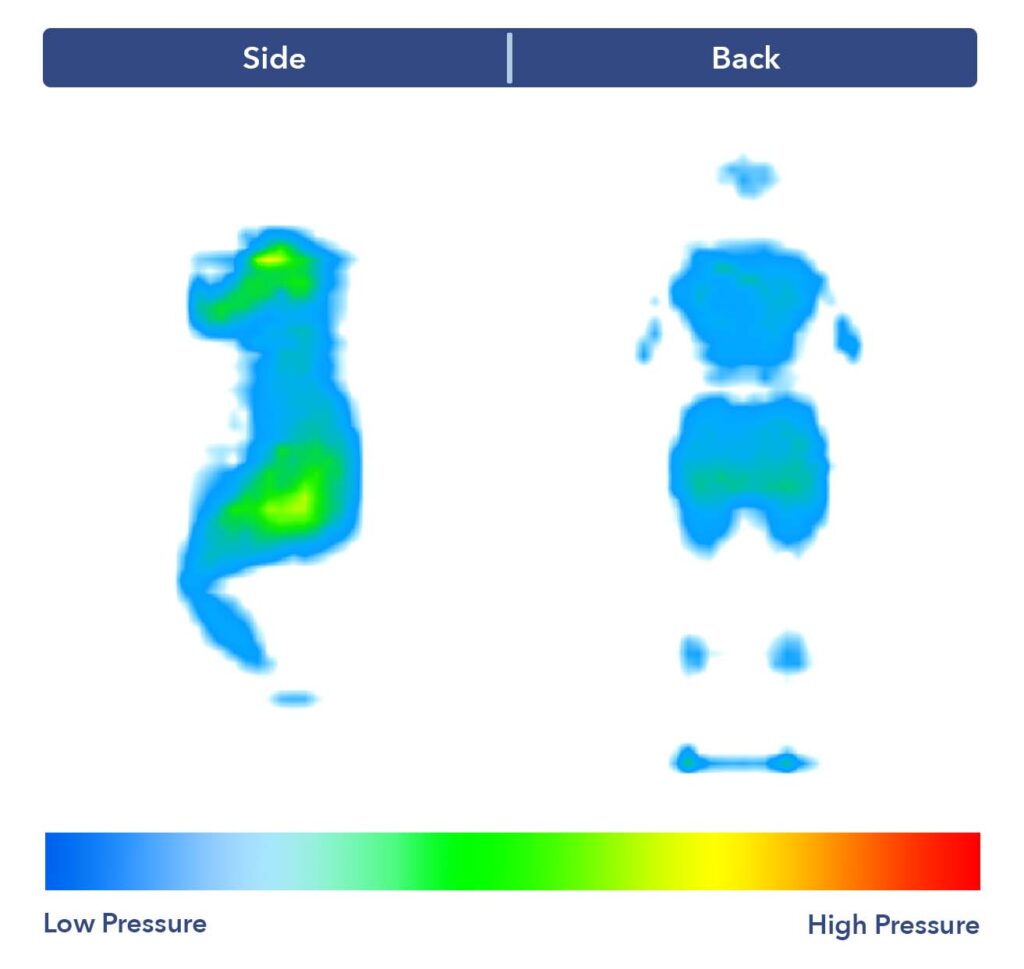
Pressure relief describes the ability of a mattress to alleviate tension in problem areas such as the shoulders, hips, and lower back. To test for pressure relief of each of our mattresses for hip pain, we use a specialized mat that we roll across the mattress. We then lie on it in various sleeping positions. The mat reads the pressure buildup on various parts of the body using thermal technology and gives us a digital map reading of those pressure points. Blue and green indicate low pressure buildup and good pressure relief, whereas red and yellow show poorer pressure relief.
For sleepers with hip pain, we recommend looking for a mattress that helps to alleviate pressure buildup around the hips and spine. A mattress that can help lift the hips and not build pressure around them may help alleviate some of the discomfort felt in that area when sleeping and during the day. Contouring foam comfort layers can also be essential for pressure relief, particularly if you suffer from chronic hip pain.
Hear From the Doctor: What Qualities in a Mattress can Provide Support and Pressure Relief?
“A mattress that provides optimal support and pressure relief typically possesses qualities such as medium-firmness, contouring materials like memory foam or latex, zoned support, responsive materials, pocketed coils, layered construction, strong edge support, and proper alignment for the spine.” – Dr. Raj Dasgupta MD, FACP, FCCP, FAASM. Quadruple-board certified in pulmonary, sleep, internal, and critical care medicine
Temperature Regulation
Your mattress’s ability to stay cool is especially important if you’re dealing with pain in a certain part of your body. If you’re experiencing hip pain, waking up during the night may already be an issue for you, so you want to be sure you are not also awoken or uncomfortable from being too warm. Ensuring that your mattress can regulate its temperature to keep you cool and comfortable throughout the night is important for this reason.
We test the cooling capabilities of the mattresses we review by measuring the temperature changes between its standing temperature and after our tester has laid on it for a few minutes. We regard anything under an 8-degree change to be good cooling, and under a 6-degree change to be great cooling.

Motion Isolation
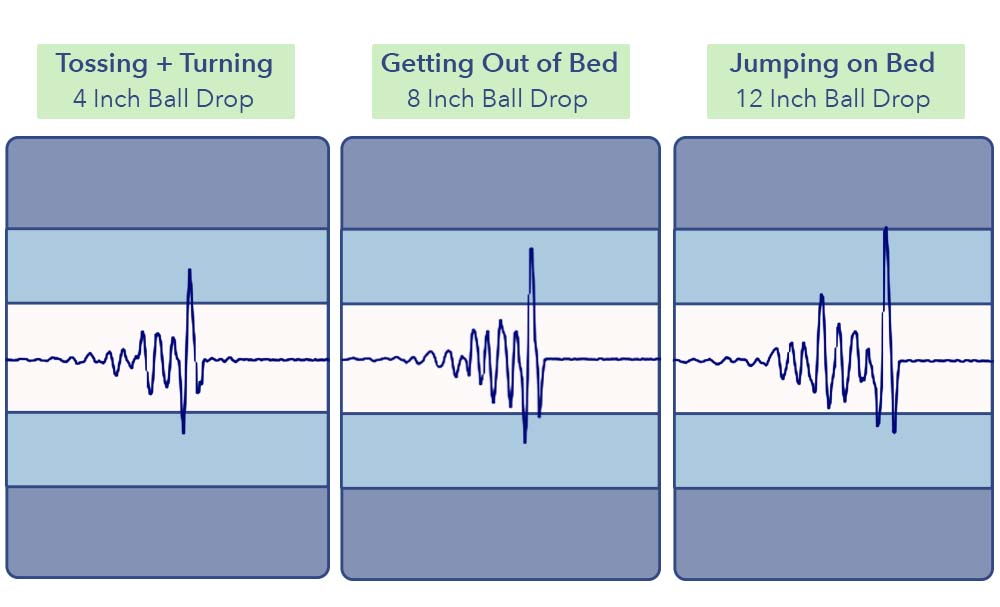

You may find yourself waking up often due to hip pain pain, and a bed with poor motion isolation may only make that worse. Motion isolation refers to the amount of movement that can be felt across the bed. This is an important consideration if you sleep with a partner or pets, as their movements could wake you up on a mattress that has poor motion isolation.
We measure the motion isolation capabilities of our mattresses using two tests. The first is a red wine test, where we place a glass of red wine on a mattress and see how much movement causes it to tip. The more movement required to knock over the glass, the better motion isolation the mattress likely has. The second test is called the ball drop test, where we drop a steel ball from various heights to mimic different movements that could be happening in the bed. We measure the amount of motion that ripples across the bed using a seismograph machine. The smaller the waves on the reading, the better motion isolation the bed has.
Hear From the Doctor: Which Features Should Side Sleepers with Hip Pain Look for in a Mattress?
“For side sleepers with hip pain, a mattress with slightly softer to medium firmness is important for cushioning the shoulders and hips. Pressure relief through contouring materials like memory foam, along with proper spinal alignment, is crucial. A supportive mattress core prevents excessive sinking, body contouring, breathability and durability enhance comfort.” – Dr. Raj Dasgupta MD, FACP, FCCP, FAASM. Quadruple-board certified in pulmonary, sleep, internal, and critical care medicine
What is the Best Sleeping Position for Hip Pain?
The short answer is that it depends. Sleep position can certainly affect the pain you’re experiencing in your hips, but each position can have drawbacks and benefits. Generally speaking, however, back sleeping is the best position for helping with hip pain, because it can keep the spine and hips neutrally aligned. Keep reading for information on mattress specifics for each type of sleeper with hip pain.
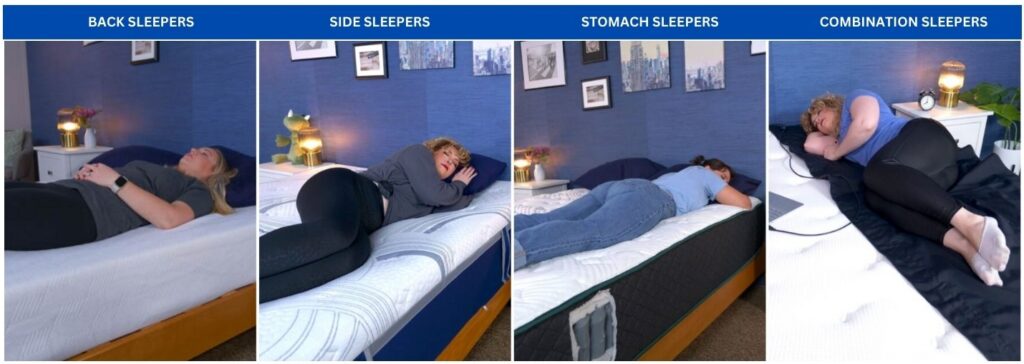
Side sleeping
Side Sleeping
Side sleeping is the most popular of all sleep positions and is the choice of 41 percent of people. Sleeping may occur on either side and take place in a fetal position or with one or both legs down.
- Pros: Sleeping on your side can keep the tongue and throat muscles from falling into the throat and causing snoring or sleep apnea. Left side sleeping can also reduce acid reflux by preventing acid from flowing into the esophagus.
- Cons: Side sleeping can cause shoulder, arm, and/or hip pain due to pressure from the mattress and poor spinal alignment. Pressure on the jaw from sleeping on your side against a pillow or mattress may result in jaw pain. If you tend to feel like this, I recommend taking a look at our best mattresses for side sleepers reviews.
Mattress firmness is an important factor for side sleepers with hip pain. A medium-soft model can help cradle the hips and provide pressure relief without too much sinkage. Heavier side sleepers may need a medium-firm mattress that helps to prevent excessive sinkage and curvature of the spine.
Back Sleeping
While only 14 percent of people sleep on their backs, back sleeping may be the healthiest of all sleeping positions. Back sleeping is often recommended for people with orthopedic conditions or after certain types of joint surgery.
- Pros: Sleeping on the back aligns the spine and helps the neck and head maintain a neutral position. Back sleeping also distributes body weight evenly and minimizes tension on pressure points. Sleeping on the back can help reduce pressure on the side and front of the hip joint, which may be helpful for many folks who experience hip pain.
- Cons: Back sleeping can allow the tongue to fall back into the throat, blocking the airway and causing snoring and sleep apnea. Back sleeping can also feel uncomfortable or awkward to some folks, who may have difficulty sleeping in this position for extended periods of time.
Sleeping on the back is often the position of choice for folks with hip pain, who may experience greater pain relief and improved spinal alignment. The right mattress for back sleepers with hip pain is typically a medium-firm model that cushions the hips and prevents gapping between the mattress and lower back. If you’re on the heavier side, a slightly firmer mattress can prevent too much sinkage that may aggravate orthopedic pain.
Stomach Sleeping
About 16 percent of folks sleep on their stomachs. Stomach sleeping is known for putting stress on the neck and spine and is generally considered the least healthy of the sleep positions.
- Pros: Sleeping on the stomach can keep the tongue from blocking the airway and reduce the risk of snoring and sleep apnea. Folks who experience hip pain when lying on their sides may prefer to sleep on their stomachs, but should be aware that the position can cause poor spinal alignment.
- Cons: Stomach sleeping can cause poor head and back alignment and counteract the natural curve of the spine. This can lead to muscle and joint pain during sleep and waking hours.
As a general rule, stomach sleepers who experience hip pain should look for a firmer mattress that will support the spine and help prevent sinking of the torso to avoid back pain. Heavier stomach sleepers typically do best with a very firm mattress that will help prevent poor spinal alignment and neck strain.
If you also tend to suffer from back pain, I recommend taking a look at our best mattress for back pain roundup.
Types of Mattresses for Sleepers With Hip Pain

What Type of Mattress is Best for Hip Pain?
We generally recommend memory foam mattresses for sleepers with hip pain. Memory foam is offered in various firmness levels, so you find the one that makes you the most comfortable, while still getting the contouring and support that you need to help alleviate hip pain. The pressure relief capabilities of memory foam can also help sleepers who have hip pain.
Memory Foam
As we mentioned, memory foam is a good option for people who have hip pain as it can offer the support, comfort, and contouring needed to help with hip pain during the night.
Memory foam is a type of polyurethane foam known for its plush, comfortable feel. When you think of memory foam, you might be imagining an ultra-soft material with a lot of sinkage, but memory foam comes in a range of firmness options, from extra-soft to extra-firm.
| Pros of Memory Foam Mattresses | Cons of Memory Foam Mattresses |
| Responds to pressure and body heat, and is touted for its ability to relieve pressure and conform to the body. This can be a great feature for hip pain sufferers, especially those who sleep on their sides | Older and less expensive forms of memory foam can retain body heat and “sleep hot.” This is less likely with newer forms such as those infused with gel and copper. |
| The absorptive quality of the material decreases motion transfer, making it a good option for partners who share a bed | Weaker edge support can cause sloping or poor spinal alignment for folks with hip pain who sleep close to the edge of the mattress. |
| Increasingly affordable, as their popularity and use have increased | Memory foam mattresses may not offer enough support or durability for some sleepers, particularly those who weigh more than 225 pounds. |
Innerspring
Innerspring mattresses are beds where the majority of the construction consists of pocketed coils. It’s one of the oldest mattress types, although mots modern brands don’t manufacture true innerspring mattresses anymore. Even if there’s a layer of springs, there’s usually a substantial amount of foam to provide some pressure relief. One exception is the Saatva Classic.
| Pros of Innerspring Mattresses | Cons of Innerspring Mattresses |
| They offer a lot of sturdy support. | They tend to be firmer beds, without a ton of contouring or sinkage. |
| The springs provide a lot of bounce and make it easy to move around and change sleeping positions. | Because coils are more expensive to manufacture than foam, modern innerspring mattresses are usually more expensive than other types of beds. |
| Because of all the space between the coils, innerspring mattresses have plenty of room for airflow and tend to sleep very cool. | They may have high motion transfer, which might be an issue if you share a bed with a partner and either one of you is a light sleeper. |
Hybrid
Like an innerspring mattress, a hybrid mattress utilizes a steel coil core for durability and structure, but adds memory foam, poly foam, and/or latex comfort layers for a satisfying balance of pressure relief and support. Innerspring mattresses are not typically recommended for hip pain sufferers, who tend to sleep best on conforming comfort layers that cradle the joints and muscles.
| Pros of Hybrid Mattresses | Cons of Hybrid Mattresses |
| Typically contain pocketed coils, which are quieter and transfer less motion than traditional innersprings | The coil structure of a hybrid mattress may transfer motion, making it feel bouncier and more disturbing to a bed partner |
| The foam comfort layers can offer plush pressure relief for hip pain sufferers, especially in softer models that utilize memory foam | May be heavier and more difficult to move |
| May be cooler than all-foam models and can be a good choice for hip pain sufferers who sleep warm at night | Less expensive hybrids may not be as durable as those made from pricier materials such as low-gauge steel coils and cooler forms of memory foam |
Latex
Latex foam is a natural product made from the sap of the rubber tree. Latex has a bouncier feel than memory foam and a quick response to pressure. The bounciness of latex may not make it an ideal option for sleepers with hip pain, but it’s exceptionally cooling because it’s naturally breathable and porous. The breathability of it, and the fact that it’s organic, also makes it a great choice for sleepers with allergies.
| Pros of Latex Mattresses | Cons of Latex Mattresses |
| The naturally airy structure of latex means that it ventilates better and sleeps cooler than some memory foams | Latex transfers more motion than memory foam, so bedmates may feel each other’s tossing and turning at night |
| Latex is a great option for hip pain sufferers who prefer natural mattress materials | A bit pricier than other foams and hybrid mattresses |
| Stomach sleepers with hip pain may prefer latex, which feels more buoyant and sinks less than other types of foam | The material doesn’t hug the body like memory foam, and may feel less comfortable for hip pain sufferers |
| Comfort layers made from latex can be a good choice for heavier sleepers who sink through memory or poly foam |
Mattress Durability, Pain Relief, and Sinkage
Each of the above materials vary when it comes to traits such as durability, pressure relief, and sinkage. The below chart lays out some of these differences, and should come in handy when you’re trying to figure out how long a specific bed might last and what kind of comfort it will offer. That said, it’s important to note that this isn’t a definitive chart and every mattress model is different. But this should help you get started if you’re unsure of what material type to buy.
| Memory Foam | Innerspring | Latex | Hybrid | |
| Durability | Average | Excellent | Great | Great |
| Pressure Relief | Excellent | Average | Average | Great |
| Sinkage | Excellent | Average | Average | Great |
Durability in a mattress refers to its ability to maintain structural integrity and comfort over time without sagging or degrading. For someone with hip pain, prioritizing durability means choosing a mattress with high-quality materials, supportive construction that can withstand long-term use while providing consistent support and alleviating pressure points. Also be on a the look out for a mattress warranty longer than 8 years to limit sagging and assurance of longevity.
Can I Add Something to My Bed to Help with Hip Pain?
You certainly can. If you’re struggling with hip pain, buying an entirely new mattress is not the only option. A mattress topper that offers extra contouring might be a good addition to your bed if you’re not in the market for a new mattress right now. The right topper can help alleviate some pain and also make your bed more comfortable. There are a lot of options for mattress toppers on the market that range in price and can help with making the bed softer, firmer, more supportive, or more contouring. Check out our recommendations for the best mattress toppers for more information.
Another option is a good pillow that helps keep your neck and spine in alignment. This alignment will be helpful for pain in these areas, as well as the hips. Keeping the neck and spine aligned healthily will help with pain across the body. While side sleeping, we’ve also had some success sleeping with a pillow between our legs to help keep the pelvis aligned. Additionally, it may be helpful to consider sleeping on your back if you don’t already to help with body alignment.
Will Adjustable Beds Help with Hip Pain?
Adjustable beds and bases can help with hip pain by allowing you to shift and find a more comfortable sleeping position that reduces pressure on your hips. By adjusting the bed’s incline, you can potentially alleviate discomfort and improve spinal alignment. However, the effectiveness varies by individual, plus an adjustable base isn’t a final solution. So it’s important to test different sleeping positions and consult with a healthcare professional for tailored advice.
Hip Pain: Common Symptoms and Causes
The hip is one of the most important joints in the body, and one of the most common sources of pain. Hip pain impacts more than 22 million Americans, including 14.3 percent of adults aged 60 and over. (1) Hip pain is considered chronic when it persists for longer than 3–6 months. (2)
Signs you Have Hip Pain:
Pain in the hip is often described as:
- Stabbing
- Shooting
- Achy
- Tight
- Stiff
Pain may also radiate to other parts of the body such as the knee and back.
Common causes of hip pain
- Osteoarthritis (OA) – OA is characterized by wearing away of the cartilage that protects the end of bones, inflammation, and changes in the tendons and ligaments. In addition to pain and stiffness, OA of the hip may cause decreased range of motion. OA is most common in older adults but can also occur in younger people.
- Other forms of arthritis – Hip pain can be caused by other forms of arthritis, too. Juvenile idiopathic arthritis affects children 16 years or younger. Rheumatoid arthritis is an autoimmune disease characterized by chronic inflammation of the joints. (3) Psoriatic arthritis is a form of arthritis that affects some sufferers of psoriasis, an inflammatory autoimmune disease. If you have any of these types, you may want to check out our Best Mattress for Arthritis list to get some relief.
- Injuries, falls, and fractures – Athletic injuries, sprains, and falls are common causes of hip pain. Hip fractures can result in chronic pain and occur most frequently in older adults.
- Overuse – Hip pain can occur because of overuse of the joint, repetitive motion such as running, or stress on ligaments and tendons.
- Autoimmune diseases – Autoimmune diseases such as lupus, multiple sclerosis, and rheumatoid arthritis are well-known causes of hip pain. (4) The immune system can cause pain by attacking healthy tissue, including the lining of joints.
- Bursitis and tendinitis – Inflammation of the small, fluid-filled sacs that cushion the hip joint, known as bursitis, can result in temporary or chronic pain. Tendinitis is irritation or inflammation of the tendon and can occur in any joint.
- Excessive weight – Being overweight or obese is a common cause of hip and other joint pain. Additional body weight can increase strain on the joint structure, increasing the risk of injury and discomfort.
Expert Tips to Relieve Hip Pain
Relieving hip pain often depends on its cause, but here are out top three strategies that can help alleviate discomfort:
- Exercise and Stretching: Gentle exercises and stretches can improve your flexibility, strengthen your hip muscles, and reduce overall pain. Activities like swimming, cycling, and specific stretching exercises (such as hip flexor stretches or hamstring stretches) can be very low impact but beneficial. If your hip pain is extreme and restricting day-to-day movement, it’s best to work with a physical therapist to ensure you’re doing exercises that are safe and effective for your specific pain.
- Hot/Cold Therapy: Applying extreme heat or cold to your hips or surrounding muscles can help manage pain and inflammation. Use a hot pack or warm bath for stiffness in your hips and cold packs or ice wrapped in a cloth for extreme inflammation or swelling. We recommend alternating between the two based on what feels best for your situation.
- Proper Rest and Activity Modification: Resting and avoiding high intensity activities or workouts that cause the pain can help speed up recovery. Modify your activities and lifestyles to reduce strain on your hips, and consider using supportive devices like ergonomic chairs, adjustable bases or cushions to reduce pressure. If your hip pain is due to overuse or a specific activity, temporarily changing your routine can make a big difference.
If the pain persists or worsens, it’s important to consult a healthcare professional to address any underlying issues and receive personalized treatment.
How We Chose These Mattresses
Our team of Certified Sleep Science Coaches has reviewed more than 300 products in our mattress lab, running each one through tests such as pressure-mapping and measuring motion transfer with a seismometer. From there, we give every bed an overall score based on materials, comfort, support, cooling, and edge support. We also factor in brand performance with categories such as value and warranty.
When selecting the best mattresses for hip pain, we knew that comfort and support would be crucial factors. Proper support results in proper alignment, and having the right pressure relief and comfort is just as important. Click here to learn more about our methodology
FAQs
Can your mattress cause hip pain?
Absolutely. A mattress that is too firm or worn out to provide adequate pressure relief can cause hip pain to develop during the night.
Is memory foam good for hip pain?
In general, yes. If a mattress has a thick layer of quality memory foam on top, it allows to sink into the bed and enjoy some pressure relief around the hip. That said, it’s important to look for a mattress that provides adequate spinal support so your hips and spine don’t get misaligned.
Is a firm or soft mattress better for hip pain?
Medium-firm mattresses are generally the best option for sleepers with hip pain. While firmness does not equate to support, a medium-firm mattress will generally offer enough support around the hips and lower back while still being contouring enough to help you get a good night sleep even with hip pain.
How will I know if my mattress is contributing to my hip pain?
Your mattress may be contributing to your hip discomfort if you feel stiff and achy in the mornings or wake up during the night in pain. You may notice that you sleep better when away from home or in a different bed. If your hip pain begins after the purchase of a new mattress, it may be due to pressure from excessively firm materials or poor spinal alignment.
A Look Into the Sleepopolis Testing Lab
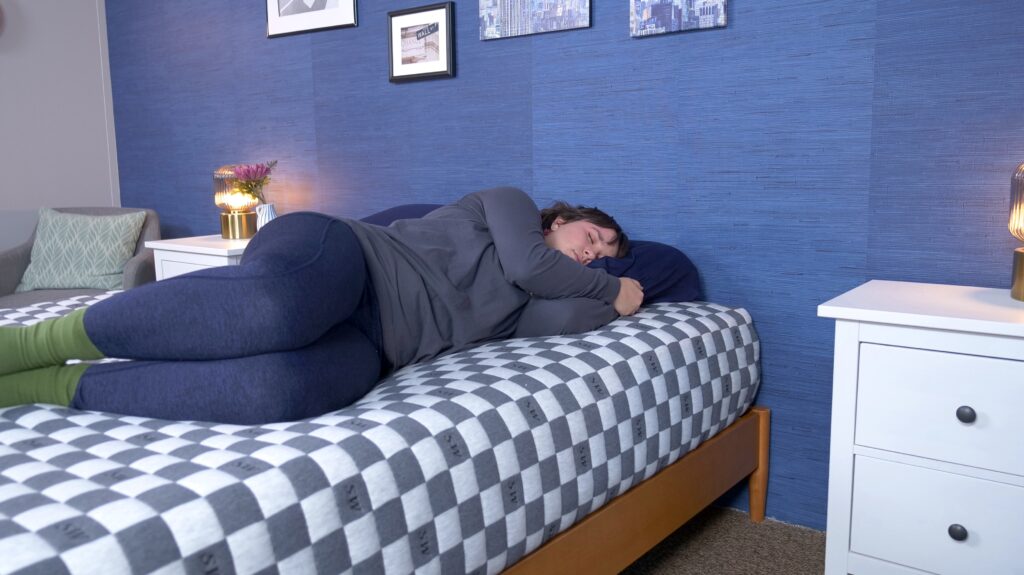
In order to ensure that we’re recommending the best mattresses to sleepers everywhere, we test each one individually in our mattress lab in Raleigh, North Carolina. Here, our team of Certified Sleep Science Coaches has reviewed more than 300 beds, putting each one through a rigorous testing process that includes measuring a mattress’s motion transfer with a seismometer, tracking its cooling capabilities with a thermal gun, and visualizing its ability to relieve pain with a pressure map.
From there, we give every bed an overall score based on its materials, comfort, support, cooling, edge support, and more. We also factor in brand performance with categories such as value and warranty.
We know that sleep is an integral part of your health, which is why we’ve developed such a detailed methodology when testing mattresses and writing our reviews. We also know that every sleeper is different when it comes to body type, sleeping position, and mattress preference. With so many factors at play, we want to give you an informed opinion so you can make an informed purchase.
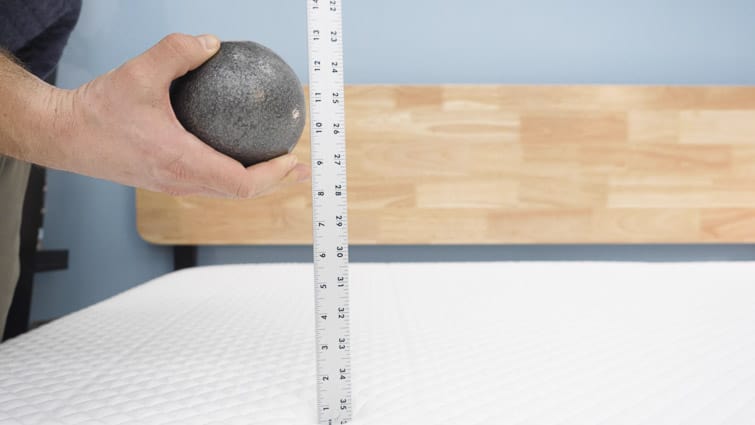
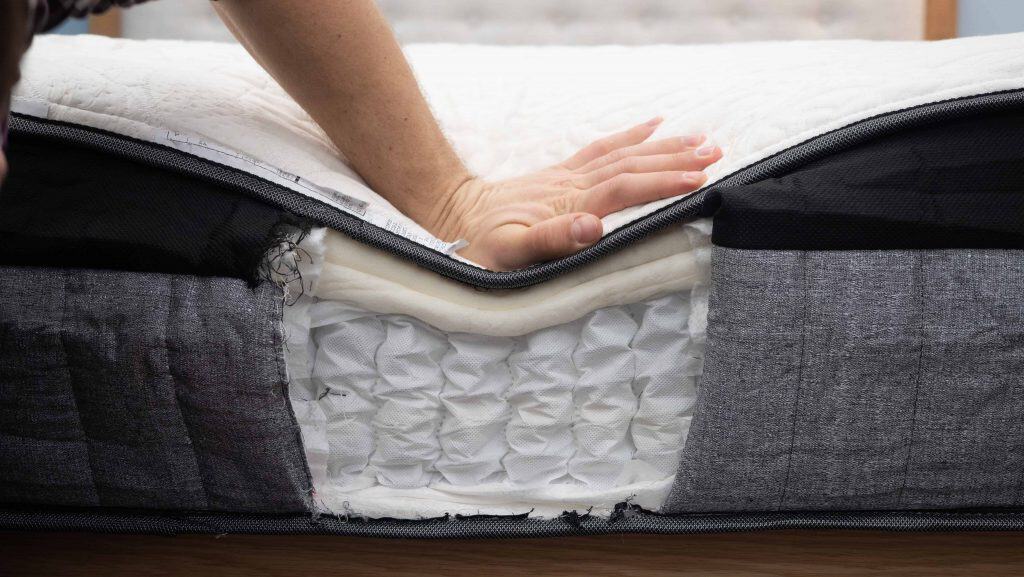
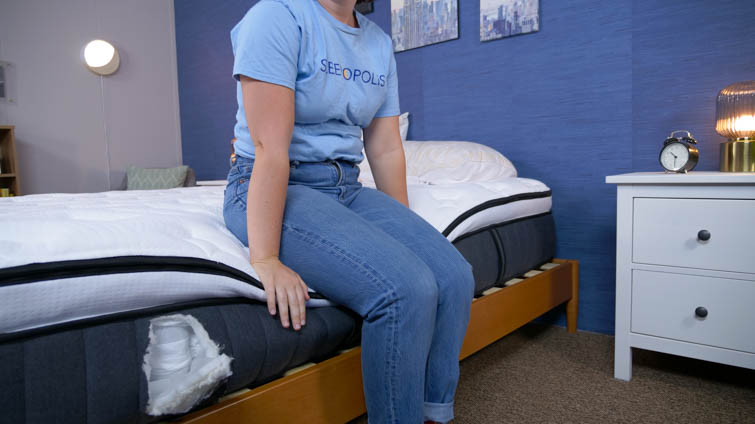
Recap: The Best Mattresses for Hip Pain of 2024
| Mattress | Best For | Price (Queen) | Coupon | Review |
| Saatva Rx | Overall | $3,295 | Saatva Coupon | Read Our Review |
| Helix Midnight Luxe | Hip Pain and Back Pain | $2,374 | Helix Coupon | Read Our Review |
| Nectar | Affordable | $1,099 | Nectar Coupon | Read Our Review |
| DreamCloud Premier | Couples | $1,832 | DreamCloud Coupon | Read Our Review |
| WinkBed | Heavy People with Hip Pain | $1,799 | WinkBeds Coupon | Read Our Review |
| Bear Elite Hybrid | Side Sleepers with Hip Pain | $2,111 | Bear Coupon | Read Our Review |
| Nolah Evolution | Shoulder and Hip Pain | $2,499 | Nolah Coupon | Read Our Review |
| Brooklyn Bedding Aurora Luxe | Arthritis | $2,265 | Brooklyn Bedding Coupon | Read Our Review |
| Titan Plus | Stomach Sleepers | $1,249 | Brooklyn Bedding Coupon | Read Our Review |
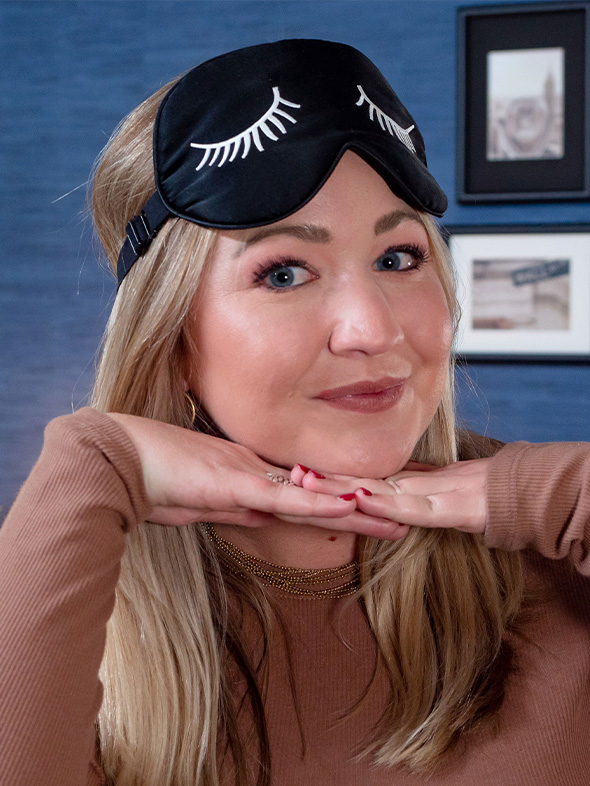
Bridget Chapman
Former Senior Product Editor
About Author
Bridget is a Certified Sleep Science Coach and senior editor here at Sleepopolis. From testing mattresses to writing about various sleep health topics, her goal is to help you get a good night’s sleep. You can also find her in videos on our YouTube channel. Bridget graduated magna cum laude from San Diego State University with a degree in journalism and a minor in English. Before joining the Sleepopolis team, she was a TV news reporter and worked in cities across the country. She loves spending time outdoors, checking out new restaurants, snuggling with her pets, and of course — getting some quality Zzz’s.
Combination Sleeper
Sources
- Christmas C, Crespo CJ, Franckowiak SC, Bathon JM, Bartlett SJ, Andersen RE, How common is hip pain among older adults? Results from the Third National Health and Nutrition Examination Survey, The Journal of Family Practice, April 5, 2002
- Treede, RD et al., A classification of chronic pain for ICD-11, Pain, June, 2015
- Krati Chauhan; Jagmohan S., Rheumatoid Arthritis, StatPearls, February 26, 2020
- Eberhardt K, Fex E, Johnsson K, Geborek P., Hip involvement in early rheumatoid arthritis, Annals of the Rheumatic Diseases, January, 1995
- J. A. Robertson et al., Sleep disturbance in patients taking opioid medication for chronic back pain, Anaesthesia, November, 2016

